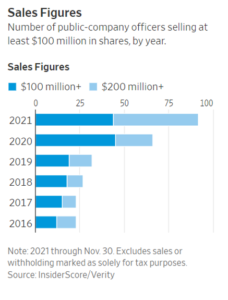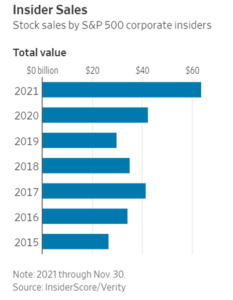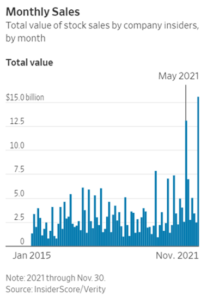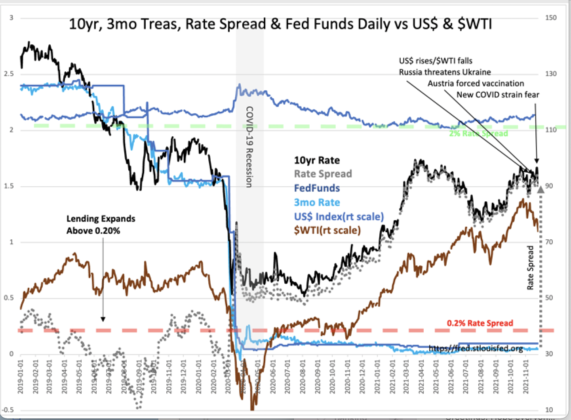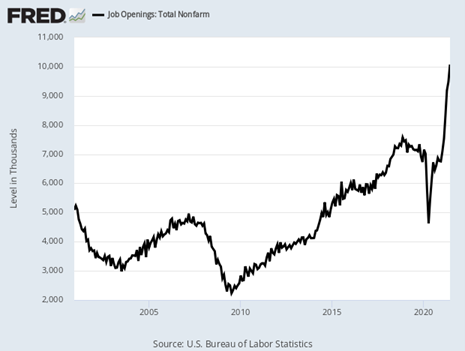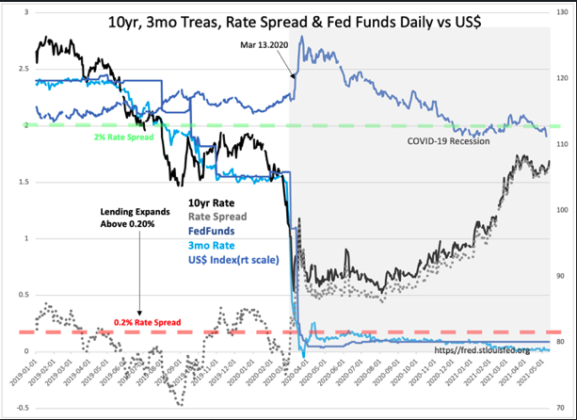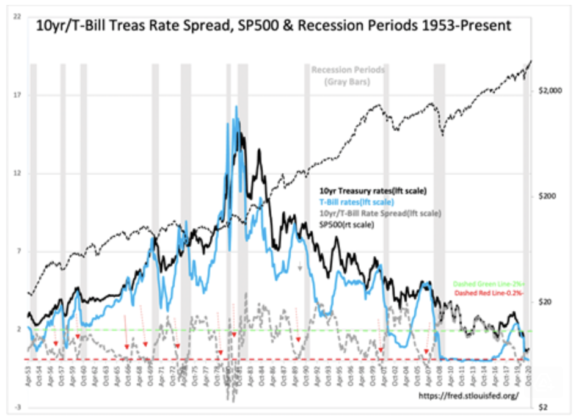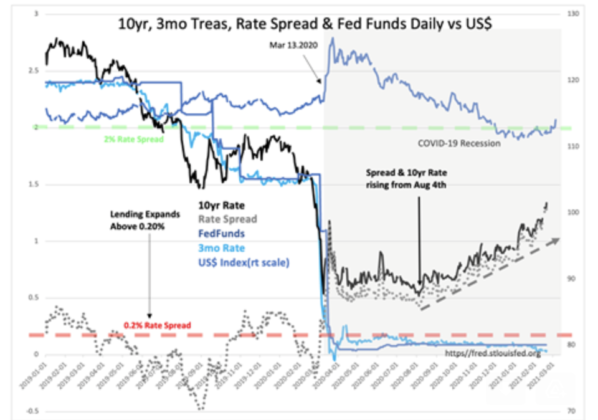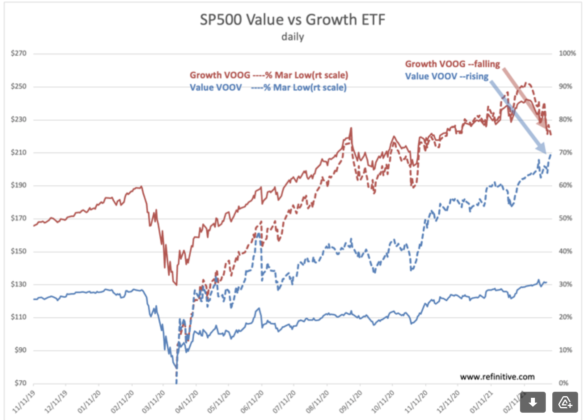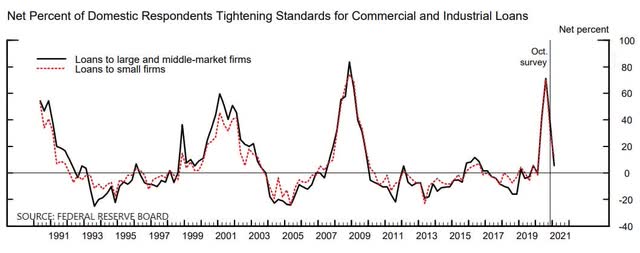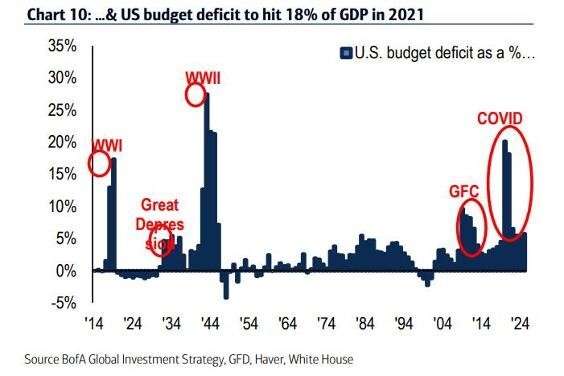Study of macro 2021
Geopolitics and macroeconomics are very critical for investment. Therefore, I need to study it thoroughly:
- 12/10/2021 – be alert that companies insiders are selling stocks at historical levels
Elon Musk, Other Leaders Sell Stock at Historic Levels as Market Soars, Tax Changes Loom – WSJ
Insiders like the Waltons, Mark Zuckerberg and Google’s co-founders have sold $63.5 billion through November, up 50% from 2020
- 12/03/2021 – US needs to contain China like Soviet Union – Today’s China isn’t the Soviet Union, but the country’s formidable strengths conceal grave weaknesses. Slowing growth, political sclerosis and looming demographic catastrophe threaten the regime. The best check on autocratic aggression remains the strength and unity of the democracies. The U.S. can work with allies to slow Chinese innovation through technological denial policies that limit its access to cutting-edge semiconductors, vast troves of American data and other crucial goods. It can complicate China’s overseas expansion by highlighting the corruption, authoritarianism and local resentment that its Belt and Road Initiative often fosters in developing countries. – Is delisting Chinese companies part of containment strategy?
Containment Can Work Against China, Too – WSJ
There are important differences between Xi Jinping’s China and the Soviet Union, but the Cold War still offers clear strategic guidance for the U.S.
Today’s China isn’t the Soviet Union, but the country’s formidable strengths conceal grave weaknesses. Slowing growth, political sclerosis and looming demographic catastrophe threaten the regime. Through his belligerence, Mr. Xi has made rivals of countries near and far. His strategy, such as it is, appears to involve seeking near-term wins—subduing Taiwan and weakening U.S. alliances in the Pacific, establishing a technological sphere of influence encompassing countries around the world—to offset, and perhaps even reverse, the accumulating effects of longer-term problems.
If Washington can block those advances, then Mr. Xi’s narrative of inevitable Chinese ascent will start to look hollow. And his successors will someday have to turn inward and address, through domestic reform and diplomatic moderation, the country’s growing isolation and the clutch of economic, political and social tensions that Mr. Xi’s policies are accentuating.
The best check on autocratic aggression remains the strength and unity of the democracies. Knowing this, Mr. Xi longs to separate Washington from its friends. Any narrowly nationalistic American approach to competition will thus fail. The U.S. will need instead deeper cooperation with like-minded countries—on trade, technological innovation and defense—to build collective resilience against Chinese aggression and to generate the collective pressure that can throw Beijing on its heels for a change.
The U.S. can work with allies to slow Chinese innovation through technological denial policies that limit its access to cutting-edge semiconductors, vast troves of American data and other crucial goods. It can complicate China’s overseas expansion by highlighting the corruption, authoritarianism and local resentment that its Belt and Road Initiative often fosters in developing countries.
The most effective long-term strategies aren’t simply passive: They bait an enemy into blunders and drive up the costs that it must pay to compete.
A strategy of this nature will make for a tense, sometimes frightening struggle.
- 11/29/2021 – Tilson’s comments
If you were to tell me that the stock market will crash by 25% or more over the next year and asked me to identify the possible reasons for it, here are my top three:
a) Rising inflation and/or debt levels worldwide will roil debt markets and spook equity investors.
b) A new COVID-19 variant will emerge that is resistant to the current vaccines, leading to a surge in deaths and a return to lockdowns.
c) We will get into a shooting war with China – likely over Taiwan.
- 11/29/2021 – watch out the volatilities coming at the week ahead: Omicron, supply-chain disruptions, a lot of economic data, with reports due on consumer confidence, private-sector payrolls, manufacturing and nonmanufacturing activity, and initial weekly unemployment claims. Friday with the release of November employment and unemployment figures. That report, along with the issuance of the Fed’s Beige Book summation of economic conditions on Wednesday afternoon. the looming debt-ceiling negotiations on Capitol Hill (in which failure to come to an agreement would force a government shutdown)
Stock Market Today: November 29, 2021
Taking a look at the week ahead, the investment community will be keeping close tabs on COVID-19 and the Omicron variant as it spreads around the globe. The new strain may cause some problems for less-vaccinated countries in both Europe and Asia, and it remains to be seen if the current vaccines will provide enough protection against it. This comes as supply-chain disruptions and bottlenecking in international trade continues to impact global output. Investors will also soon get a lot of economic data, with reports due on consumer confidence, private-sector payrolls, manufacturing and nonmanufacturing activity, and initial weekly unemployment claims. The headline report will come on Friday with the release of November employment and unemployment figures. That report, along with the issuance of the Fed’s Beige Book summation of economic conditions on Wednesday afternoon, will be closely watched by monetary policy decision-makers ahead of next month’s FOMC meeting.
The Fed’s stance on monetary policy, the looming debt-ceiling negotiations on Capitol Hill (in which failure to come to an agreement would force a government shutdown), inflation concerns and related supply-chain disruptions, and the renewed fear of the COVID-19 Omicron variant are together forming a “wall of worry” for Wall Street, and this uncertainty may lead to a near-term spike in equity market volatility. Given this backdrop, investors may be best served by adding some quality names to their portfolios, which, as noted above, can be found among the issues ranked 1 and 2 for Safety by Value Line. The company’s stock-screening capabilities can make the potentially daunting task of identifying these stocks quite easy. For example, the mega-cap technology names offer the best combination of high-growth potential and safety, which also made them popular holdings at the height of the coronavirus pandemic last year.
- 11/27/2021 –
Margin Debt and the Market: Up 3.6% in October
- 11/26/2021 – Each “Crisis” Has Been A Buying Opportunity
“Davidson” submits:
Every market has multiple events deemed a ‘pending crisis’ which results in panics some longer and some shorter. One rule has held over many cycles and that has been, ‘Buy on every ‘crisis’ if the market reflects strong liquidity.”
Buy on every ‘crisis’ if the market reflects strong liquidity.
Liquidity and market psychology are highly correlated. If investors have adequate liquidity, then they do not panic when an earthshaking event hits the headlines as the new COVID strain has done today. The T-Bill 10yr Treasury rate spread is a combined proxy for liquidity and market psychology. It provides a measure for how far investors have ‘gotten over their skis’ in Wall Street parlance. Investors always panic on unexpected negative news and reassess market exposures vs the newly defined risk. Some will pare back positions on the first headline, while others will wait to be better informed as more detailed information emerges. Investor responses are dependent on how much one feels exposed to price declines. If one has adequate liquidity and market experience, one tends to ride out every new negative as something that can be worked through if a general economic expansion appears unthreatened. Those with the least experience tend to panic and sell positions precisely because they have been the least cautious at being prepared for unexpected negatives that more experienced investors have built into their strategies. It is the same every cycle.
The current T-Bill 10yr Treas rate spread is ~1.5-1.6% and has been widening since we exited the COVIS lockdown. Every important economic indicator, retail sales, employment and so on across every economic parameter reflects economic expansion. While a new COVID strain is to be expected, we have already had some 3,000 variants which is typical for a virus, it only becomes a “Black Swan” if investors are unable to deal with short term liquidity that arises from being overly committed to longer-term strategies with borrowed funds i.e., margin. This all-in investment position is reflected when the rate spread falls to 0.2% on rising T-Bill rates as investors commit all their capital including rainy day capital for higher returns. The history of this measure indicates ample liquidity exists to deal with today’s negative headline.
Today is a buying opportunity in my opinion within a strong economic expansion period.
- 11/02/2021 – Tilson still thinks “the mother of all economic booms” is still underway. Scott Grannis also thinks future economic growth will be at least decent
from Tilson’s daily
My friend David Berman of Durban Capital organized a birthday lunch for me yesterday. My colleague Berna Barshay and four other friends from the investment world joined us, so naturally, we talked about stocks.
My main takeaway from the conversation is that what I’ve been calling “the mother of all economic booms” is still underway.
In summary, while I tend to avoid making market forecasts, I think the odds are good that stocks will be up between now and the end of the year.
But the point remains (and is equally true today… I think): Just because things are getting foolish in the markets (or particular sectors) doesn’t mean they can’t get a lot more foolish…
Here are a few updated charts that track important information:
Today saw the release of September capital goods orders (Chart #1). Once again they were pretty strong. Capex (shorthand) is important because it is business investment in things that will enhance worker productivity in the future. This is therefore a good sign that future economic growth will be at least decent.
- 10/12/2021 – the three top possible risks on market from Tilson: In fact, I’d estimate that there’s only a 10% chance that the market declines more than 25% from today’s level at any point over the next 12 months, and there’s a less than 3% chance of a 50% decline. But the odds aren’t zero either…
1) If you were to tell me that the stock market will crash by 25% or more over the next year and asked me to identify the possible reasons for it, here are my top three:
a) Rising inflation and/or debt levels across the world will roil debt markets and spook equity investors,
b) A new COVID-19 variant will emerge that is resistant to the current vaccines, leading to a surge in deaths and a return to lockdowns, or
c) We will get into a shooting war with China – likely over Taiwan.
(Other possibilities not in my top three include an economic crash in China, a collapse of the cryptocurrency sector (whose market cap now exceeds $2.3 trillion), and a terrorist using a nuclear or biological weapon in a major city.)
To be clear, I don’t think a market crash due to these – or any other – scenarios is likely.
In fact, I’d estimate that there’s only a 10% chance that the market declines more than 25% from today’s level at any point over the next 12 months, and there’s a less than 3% chance of a 50% decline.
But the odds aren’t zero either…
- 10/03/2021 – really worth reading and prepare for it
The Volatility Squeeze
The next great short squeeze has begun; it will crash the market
- 08/27/2021 – ASA staffing Index and steel production level is back to 2019 level, all others are in the way to come back
Click here for this week’s Recovery Tracker
- 08/26/2021 – economic boom?
Speaking of the economic boom, check out this chart of nonfarm job openings (source) – WOW!
|
- 08/20/2021 – stock market might be too high for too long. Prepare for the pull back
S&P 500 hasn’t fallen 5% from a peak in nearly 200 sessions — what that tells market historians
the S&P 500 index SPX, 0.70% has seen a largely uninterrupted ascent to such a degree that this Friday, absent a sharp selloff, will mark the 200th session without a drawdown of 5% or more from a recent peak, making the current stretch of levitation the longest such since 2016, when the market went 404 sessions without falling by at least 5% peak to trough.
| Start data | End date | S&P 500 Gain During Streak | Days Without a 5% Pullback |
| Aug. 19, 1958 | Sept. 8, 1959 | 22.2% | 266 |
| Jan. 4, 1961 | Jan. 9, 1962 | 20.1% | 255 |
| Nov. 26, 1993 | June 8, 1965 | 23.4% | 386 |
| Oct. 12, 1992 | March 28, 1994 | 14.2% | 370 |
| Dec. 21, 1994 | July 12, 1996 | 41.4% | 394 |
| Oct. 21, 2014 | Aug. 20, 2015 | 6.9% | 210 |
| June 28, 2016 | Feb. 2, 2018 | 38.1% | 404 |
| Nov. 4, 2020 | Aug. 20, 2021 | 200* (assuming no fireworks on Friday) | |
| Source: Dow Jones Market Data |
It is extremely rare for the market to enjoy such a period of relative effervescence. Indeed, such lengthy stretches without a 5% pullback or better have occurred on only eight occasions in the S&P 500 index, the attached table shows.
- 06/14/2021 – record corporate debt on historical low interest environment. What will happen if interest rate jumps?
Pandemic Hangover: $11 Trillion in Corporate Debt – WSJ
Stressed companies piled on debt as interest rates plummeted, but could face a reckoning in the next economic downturn
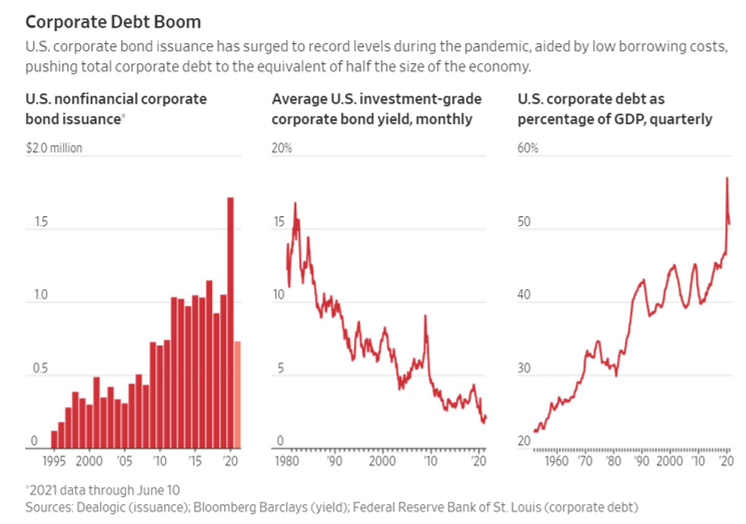
- 06/03/2021 – If the job growth in May coming out tomorrow is quite strong, inflation concerns could reappear, and the size of the expected infrastructure spending bill might wane.
Stock Market Today: June 3, 2021
Earlier this morning, Automatic Data Processing (ADP) reported that private-sector payrolls increased by 978,000 last month (the expectation called for 680,000 new positions), and at 8:30 A.M. (EDT), government figures showed that initial weekly unemployment claims fell to a pandemic era low of 385,000. The major averages, which have been rather directionless over the first two trading days of June, were down before the open. If the job growth in May coming out tomorrow is quite strong, inflation concerns could reappear, and the size of the expected infrastructure spending bill might wane.
Diving deeper into forces driving the markets, the equity futures are presaging a lower opening when trading commences stateside. The investment community did not like to hear that the Federal Reserve may soon begin tapering some of its bond-buying measures. The U.S. dollar weakened on this news. Likewise, investors both here and abroad are reacting negatively to reports that the United Kingdom is considering delaying the final stage of reopening by two weeks if hospitalizations and deaths from COVID-19 increase. Geopolitical tensions are heightened after Russia’s finance minister announced that with the country facing additional economic sanctions from the United States, it will remove all of the U.S. dollar assets from its National Wealth Fund and instead shift to euros, Chinese yuan and gold.
- 06/02/2021 – The U.S. economic recovery is unlike any in recent history, powered by consumers with trillions in extra savings, businesses eager to hire and enormous policy support.
The Economic Recovery Is Here. It’s Unlike Anything You’ve Seen. – WSJ
The U.S. economic recovery is unlike any in recent history, powered by consumers with trillions in extra savings, businesses eager to hire and enormous policy support. Businesses and workers are poised to emerge from the downturn with far less permanent damage than occurred after recent recessions, particularly the 2007-09 downturn.
New businesses are popping up at the fastest pace on record. The rate at which workers quit their jobs—a proxy for confidence in the labor market—matches the highest going back at least to 2000. American household debt-service burdens, as a share of after-tax income, are near their lowest levels since 1980, when records began. The Dow Jones Industrial Average is up nearly 18% from its pre-pandemic peak in February 2020. Home prices nationwide are nearly 14% higher since that time.
The speed of the rebound is also triggering turmoil. The shortages of goods, raw materials and labor that typically emerge toward the end of an expansion are cropping up much sooner. Many economists, along with the Federal Reserve, expect the jump in inflation to be temporary, but others worry it could persist even once reopening is complete.
“We’ve never had anything like it—a collapse and then a boom-like pickup,” said Allen Sinai, chief global economist and strategist at Decision Economics, Inc. “It is without historical parallel.”
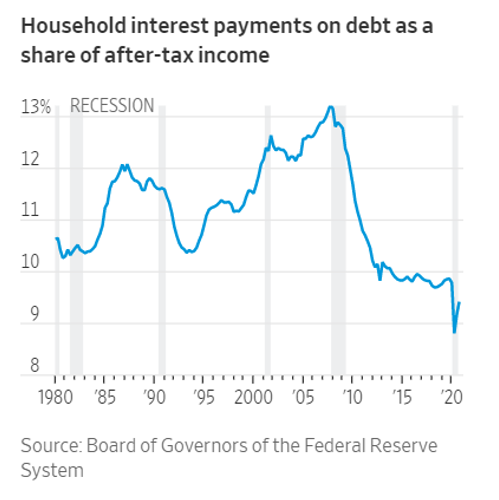
- 05/30/2021 – Good to learn the stock history from Stanley Druckenmiller, especially on the parallels between the recent tech sell-off and the Dotcom Bubble
I really enjoyed this interview with investing legend Stanley Druckenmiller, who has never had a down year in more than four decades of investing and once compounded at more than 30% annually over 30 years. Here’s an overview of the topics he covers:
- What makes a great investor
- How he makes an investment decision
- Whether we are in another tech bubble
- What career advice he has for 20-year-olds
- What he thinks of crypto (bitcoin, ethereum, and dogecoin)
- Which Big Tech firm will be the first to reach a $5 trillion valuation
Here’s Druckenmiller on the implications of the “incredible wave of digital transformation”:
From 1995 to 2000, you had an incredible wave while the Internet was being built. What you have now is this incredible wave of digital transformation, particularly moving onto the cloud.
I used to say two to three years ago in some interviews that we’re in the bottom of the first or second inning in terms of digital transformation. And this is a 10-year runway.
Well, COVID sort of jumped you from the bottom half of the first inning to the sixth inning. I think [Shopify (SHOP) CEO Tobi Lütke] said we went from 2019 to 2030 [in terms of e-commerce sales] in one year.
I think the difference now is if you haven’t moved to the cloud, you’re dead because who you’re competing against, they can just beat you because the technology is so important.
So, now, full disclosure, I didn’t see what was coming in 2000. But I [have a difficult time coming up] with a scenario that this digital transformation thing is going to collapse and these SaaS [Software-as-a-Service] companies are going to go away.
The biggest problem you have now is the overall bubble and asset prices. The good news is if we had this conversation two months ago, the good [SaaS stocks] were like 45 times to 50 times sales. Not earnings but sales. They’re down to – there’s a range – I’d say now 10 times to 25 times sales for the good ones.
So, if the problem is price and – in my opinion – that is the problem: a lot of that has been wrung out. And I think if you hold these names for three to four years, they could easily grow into their valuations.
On which stock might reach a $5 trillion valuation first:
So, before I give my first guess: I have no idea.
If you put a gun to my head or we’re going to Vegas:
No. 1 would be Amazon.
No. 2 would be Microsoft.
Google could have a big pop, ironically, if the government breaks them up because their core search business is literally the best business I’ve ever seen.
But they keep trying all this experimental stuff that challenges shareholder value. But those guys are so rich. They’re more interested in changing the world right now and good for them.
On making concentrated, high-conviction bets:
When I’ve looked at all the investors [that] have very large reputations – Warren Buffett, Carl Icahn, George Soros – they all only have one thing in common.
And it’s the exact opposite of what they teach in a business school. It is to make large, concentrated bets where they have a lot of conviction.
They’re not buying 35 or 40 names and diversifying.
I don’t know whether you remember that Icahn a few years ago put $5 billion into Apple. I don’t think he was worth more than $10 billion when he did that.
[In 1992] when I went in to tell Soros that I was going to short 100% of the fund in the British pound against the Deutschmark, he looked at me with great disdain.
He thought the story was good enough that I should be doing 200%, because it was sort of a once-in-a-generation opportunity.
So, [these investors] concentrate their holdings. This is very counterintuitive.
In my thinking, [concentrating your bets] decreases your overall risk because where you tend to be in trouble is if you have 35 or 40 names.
If you start paying attention to one. If you have a big, massive position, it has your attention.
My favorite quote of all time is maybe Mark Twain: “Put all your eggs in one basket and watch the basket carefully.”
I tend to think that’s what great investors do.
On knowing when to sell and using stop losses:
The other thing to me [that makes a good investor] is you have to know how and when to take a loss. I’ve been in business since 1976 as a money manager.
I’ve never used the stop loss. Not once. It’s the dumbest concept I’ve ever heard. [If a stock goes down 15%] I’m automatically out.
But I’ve also never hung onto a security if the reason I bought it has changed. That’s when you need to sell.
If I buy X security for A, B, C, and D reasons, and those reasons are no longer valid, [I sell].
Whether I have a loss or a gain, that stock doesn’t know whether you have a loss or a gain.
You know, it is not important. Your ego is not what this is about. What this is about is you’re making money.
So, if I have a thesis and it doesn’t bear out – which happens often with me, I’m often wrong – just get out and move on.
Because I said earlier: if you’re using the most disciplined approach, you can find something else. There’s no reason to hang on to any security where you don’t have great conviction.
On the parallels between the recent tech sell-off and the Dotcom Bubble
Takeaway: Like the Dotcom Bubble, current tech valuations are “speculative”. However, Druckenmiller believes today’s high-growth tech stocks — particularly those involved with digital transformation (e.g., cloud stocks) — will be able to grow into these valuations within 3-4 years.
Stanley Druckenmiller: I’m seeing some similarities and I’m seeing some differences [with tech stocks today and during the Dotcom Bubble at the turn of the century].
Number one: valuations in both periods go to what I would call “speculative levels”.
Monetary policy was part of the issue in 1999, when [Fed Chairman] Alan Greenspan decided he would run an experiment and let unemployment go to lower levels than it had historically been.
It’s nothing like the crazy stuff we’re doing now, but that helps set it up for what was really going on back then.
Think about the fact that Netscape really didn’t really exist until 1995. So, other than some nerdy professors back in the early 80s, no one even had email, right? The internet was just sort of being built and the big winners in 1999 were companies like Sun Microsystem and Cisco, that were building the guts of the internet.
The growth was so rapid as this went on and valuations — combined with some easy money — got baked in.
But think of the internet infrastructure like the railroads 150 years ago. Think of the tech stocks like a company selling railway ties and building the guts of the internet.
When you’re building the railroad, your sales are going up +50, +60 or +70% a year. But once the railroad is built [you don’t need the railway ties anymore]. Your growth not only doesn’t go up 70%, it goes down because on a rate of change basis, you don’t need any more railroad ties.
None of us — me included — saw that in early 2000. A lot of these companies with estimates of +50-70% growth for the next 2-3 years had businesses that were literally about to collapse. So the NASDAQ went down 95%. Not 30%, but 95%. Because you had this combination of inflated values, way over-estimated earnings and then an earnings collapse.
Today, you have something similar and something different. Monetary policy is absolutely insane. We had no quantitative easing (QE) back then. And our [interest] rates weren’t 0%. They were 4% or 5% when they probably should have been 6% or 7%. No comparison.
So we have an asset bubble. Now that’s not just in tech stocks, it’s in everything. I know some of the [young] backers of Dogecoin might disagree.
If you’re an asset, you’ve been moving.
From 1995 to 2000, you had an incredible wave while the internet was being built. What you have now is this incredible wave of digital transformation, particularly moving onto the cloud.
I used to say 2-3 years ago in some interviews that we’re in the bottom of the first or second inning in terms of digital transformation. And this is a 10-year runway.
Well, COVID sort of jumped you from the bottom half of the first first inning to the sixth inning. I think [Shopify CEO Tobi Lutke] said we went from 2019 to 2030 [in terms of e commerce sales] in one year.
I think the difference now is if you haven’t moved to the cloud, you’re dead because who you’re competing against, they can just beat you because the technology is so important.
So, now full disclosure, I didn’t see what was coming in 2000. But I [have a difficult time coming up] with a scenario that this digital transformation thing is going to collapse and these SAAS companies are going to go away.
The biggest problem you have now is the overall bubble and asset prices. The good news is if we had this conversation 2 months ago, the good [SAAS stocks] were like 45-50x sales. Not earnings but sales. They’re down to — there’s a range — I’d say now 10-25x sales for the good ones.
So if the problem is price and — in my opinion — that is the problem: a lot of that has been wrung out. And I think if you hold these names for 3-4 years, they could easily grow into their valuations.
[In comparison] if you held the names in 2000, a lot of these companies you still would have lost 90% of your value, right? So those are the similarities and those are the differences.
- 05/28/2021 – what opportunities can I find in his plan?
Biden Unveils $6 Trillion Spending Plan – WSJ
WASHINGTON—President Biden’s $6 trillion budget proposal unveiled Friday charts his vision of an expansive federal government role in the economy and the lives of Americans, with big increases in spending on infrastructure, public health and education along with tax increases on corporations and the wealthy.
The Biden administration is seeking $1.52 trillion for spending on the military and domestic programs in fiscal year 2022, which begins Oct. 1, an 8.6% increase from the $1.4 trillion enacted last year, excluding emergency measures to combat the Covid-19 pandemic.
The proposal would shift more federal resources from the military, which would see a 1.6% rise in spending next year, to domestic programs such as scientific research and renewable energy, which would receive 16.5% more funding under the president’s plan in 2022.
The White House also detailed costs for its proposals to spend $4.5 trillion over the next decade on infrastructure and social programs, which the administration is hoping to advance through Congress this summer. The plan would provide $17 billion next year for infrastructure improvements, including repairs to roads, bridges and airports, $4.5 billion to replace lead water pipes across the country, and $13 billion to expand high-speed broadband.
Plans to provide universal preschool and ensure teachers at those schools earn $15 an hour would cost $3.5 billion in 2022. The budget would also provide $8.8 billion next year on direct spending on families, including $6.7 billion for affordable child care, and $750 million for paid leave, the costs of which would rise substantially in 2023 and beyond.
The budget incorporates the administration’s eight-year, $2.3 trillion infrastructure proposal and its $1.8 trillion American Families Plan and adds details on his $1.5 trillion request for annual operating expenditures for the Pentagon and domestic agencies.
- 05/24/2021 – the industrial, financial, energy, and consumer staples companies would fare the best in a period of higher prices (inflation). The earning power of the financial companies, particularly the banks, would be enhanced by higher lending rates.
Stock Market Today: May 24, 2021
The main theme on Wall Street this spring has been the rotation out of the high-growth stocks and into the value names. As noted, this has been brought about by continued concerns about inflation and the possibility that the central bank will raise interest rates ahead of its planned target of 2023. The value stocks in the cyclical areas have been the beneficiary of late, with the thought being that the industrial, financial, energy, and consumer staples companies would fare the best in a period of higher prices. They have the best ability to pass the higher costs along to the consumer, as people need food and energy products to live their lives. The earning power of the financial companies, particularly the banks, would be enhanced by higher lending rates. Investors, though, should note that this recent sector rotation is starting to make some of the value stocks a bit expensive versus their historical norms. Perhaps, the reason why we are seeing some selective movement back into the recent out-of-favor groups.
- 05/20/2021 – there is an enormous amount of cash sitting on the sidelines, estimated to be upwards of $4 trillion. – this has the potential to drive up the value and cyclical stocks
Stock Market Today: May 20, 2021
Investors should note that with many of the top hedge funds recently taking profits in the high-growth areas where valuations are stretched after tremendous advances last year, there is an enormous amount of cash sitting on the sidelines, estimated to be upwards of $4 trillion. This trend can either be good or bad news for traders. If further profit taking occurs, or if the funds simply hold their large cash balances, it could put further near-term downward pressure on stocks. But if the economy continues to recover and the inflation concerns prove transitory (the Federal Reserve’s current stance), there could be a rush of buying later this year. In this environment, even with the uncertainty of inflation and possible changes to the U.S. tax code lingering, we would recommend keeping a significant portion of funds in the equity market, particularly in the value and cyclical categories that will get a boost from further re-openings. With fixed-income yields low, bonds are still not providing much of an investment alternative to stocks. – William G. Ferguson
- 05/19/2021 – Great article on interest rate and stock market from Davidson
Market prices despite the many predictions by professionals have never followed a cohesive logic connected to fundamentals. Prices of everything bought/sold are set by market activity driven by market psychology of what things are worth. Markets fluctuate dependent on market psychology of the moment fed by media headlines. Human activity is market activity and includes product, service and information exchange. When you look deeper, products and services are items derived from information and innovation repurposed into business offerings on which individuals derive profit. Most stop their analysis at evaluating what stocks and bonds are worth, but what something is worth is at all times a moving target of information exchange. If the idea improves standards of living better than other ideas, it sells better and produces profit for the innovator. In the marketplace innovators offer ideas but it is consumers who make the judgement on utility. While businesses are believed to set prices, prices are in fact set by consumer willingness to purchase. This is an individual value judgement of one offering vs other offerings. What people believe things are worth differs frequently from fundamental measures. This is the crux of Momentum vs Value Investing. Momentum investors believe prices reflect intrinsic value but Value investors see prices as only what investors are willing to pay for fundamentals.
Markets always reflect a wide gap between prices and fundamentals with areas mispriced based on the themes of the moment. Today two themes are playing out, the ‘stay-at-home’ vs the ‘back-to-work’ as investors cope with the economic impact of COVID. Media headlines can be pessimistic one hour and optimist the next in an ebb and flow too fast to fathom with common sense. Advisors promoting their expertise (and seeking new clients) provide so many short-term streams of direction it is a muddle based on enigma.
How one makes sense of it all is to ‘connect the dots’, i.e. all the dots possible to find the fundamental drivers of market pricing. The ‘dots’ comprise a wealth of inputs but when one works through it, simple relationships become apparent. Over the short-term these patterns do not jump out of you but longer-term they are far more obvious. Net/net it is fundamentals over the long-term that drives market psychology despite the presence of an unpredictable quicksand of short-lasting themes. Short-term market themes provide head-fakes throughout every market cycle. This creates confusion for any investor with a short-term trading mindset. Short-term themes are very much like being in a house of mirrors. Bitcoin is one of these.
Rates are market prices set by market psychology. Rates, especially the Rate Spread is a good measure of the current state of investor psychology and provides insight to the overall condition of speculation during a cycle. Every cycle since the Fed has kept track of rates, since 1953, has displayed the same pattern:
In recession the yield curve is inverted and rates are at the low point of the cycle
- Emerging from recession 10yr Treasury rates rise while T-Bill rates lag as investors gain confidence and seek higher returns but keep some capital aside, rate spread widens.
- Middle of the cycle T-Bills rates begin to rise with 10yr Treasury rates as investor confidence expands. Roughly a 2% rate spread range. Bank lending accelerates with net income profits and economic activity is spurred higher.
- Speculation begins to develop and investors shift capital out of T-Bills forcing the rate spread to narrow.
- Speculation and bank lending continues till the rate spread narrows to 0.2% reducing lending profits significantly. Rates are at the top of the cycle. At this point, banks and investors are over-leveraged and additional capital coming into the economy and markets slows. Defaults in over-leveraged businesses creates a domino cascade into the next recession.
Rates are not fundamental measures of economic activity but a measure of market psychology and investor positioning. The fundamental measures that provide the economic background are employment indicators, measures of goods manufacturing and transport, measures of retail consumption and etc. The trends in fundamentals is what eventually drives investor psychology to shift capital seeking the better perceived risk/return at any point in time. Investors pushing rates higher in the shift from fixed income to equities does eventually impact the cost of doing business and hiring new employees. It is a feedback mechanism between market psychology and economic activity that is always present. This is a long-term relationship not the short-term impact reported to be shifting daily in the media. In ‘connecting the dots’, it is the long-term dots which connect best with the rest of the information being head fakes regarding actual long-term returns.
At this point in the current cycle, T-Bill rates remain near record lows as 10yr Treasury rates continue to rise. Even though it should be apparent we exited recession April 2020, more than 12mos ago, many continue speak as if we remain in recession and demand further stimulus.
There are copious levels of liquidity present. It appears we are roughly half way towards the next economic/market top with ~8mil individuals still to reenter the economy. There are pockets of rank speculation in SPACs, in Internet related ‘stay-at-home’ and new but untested technology companies and the latest craze, Bitcoin and other cryptocurrencies. The valuations are non-existent in many of these reflecting Momentum themes based purely on price with fundamentals and common sense lacking altogether. Cryptocurrencies are unconnected to economic activity. Fearing a top is not new for those involved only in these issues ignoring the fundamentals of long-term economics vs pricing. Recognize the differences in Momentum vs Value Investing and employ both in your thinking. Be balanced! Reassert that balance every day.
Connect the long-term dots and ignore what is in between as noise. The fundamentals remain in uptrends and the rate spread continues to indicate tops are a ways off into the future as do fundamentals. Perhaps there is a top in 3yr-5yrs. Not today!
- 04/14/2021 – central bank will reduce bond purchasing WELL before raising interest rate. Be aware of this
Fed chairman notes that most central-bank officials see rates remaining near zero through 2023
Federal Reserve Chairman Jerome Powell said Wednesday that the central bank will begin to slow the pace of its bond purchases “well before” raising interest rates.
The Fed has been buying at least $120 billion a month of Treasury debt and mortgage-backed securities since last June to hold down long-term borrowing costs. Since December, the central bank has said the economy must make “substantial further progress” toward its goals of maximum employment and 2% inflation before it scales back those purchases.
“We will taper asset purchases when we’ve made substantial further progress toward our goals, from last December when we announced that guidance,” Mr. Powell said in a virtual event held by the Economic Club of Washington, D.C. “That would in all likelihood be before—well before—the time we consider raising interest rates.”
- 04/09/2021 – economy is on the cusp of a boom, inflation might come temporarily at spring
The economy is on the cusp of a major boom and economists believe it could last
- The economy is just starting a boom period, where second quarter growth could top 10%, and 2021 could be the strongest year since 1984.
- The second quarter is expected to be the strongest, but the boom is not expected to fizzle, and growth is expected to be stronger than during the pre-pandemic into 2022.
- A period of supercharged growth is just starting, and it is showing up in surging consumer spending and in an increasing shortage of skilled workers.
- With surging demand could come inflation, something the economy has avoided for more than two decades.
Fed Chairman Jerome Powell has gone out of his way to stress the Fed will keep policy low, and that he expects a transient jump in inflation in the spring.
Hyman, in his note, said it’s possible inflation could rise to 3%. The personal consumption expenditures price index, watched by the Fed, was up 1.6% on an annual basis in February, and JP Morgan economists expect it to rise to 1.8% in March.
Powell has said higher inflation should show up this spring because of the base effect, compared to last year’s weak numbers. He said inflation should be transitory, and bottlenecks in supplies should be temporary.
- 04/01/2021 – “We want to see progress by Memorial Day, we’d like to see this package passed by the summer. But I certainly expect when Congress returns that the president will be inviting members to the Oval Office.” – so the timeline is end of May to see progress, passed by the summer (June 21 ~ Sept 22).
White House hopes to see infrastructure bill passed by summer
President Biden hopes to see Congress pass his infrastructure and climate proposal by this summer, White House press secretary Jen Psaki said Thursday, setting a slightly longer timeline than his recently enacted coronavirus relief package.
Psaki told reporters at an afternoon briefing that the extra time will allow for more White House negotiations with congressional Republicans and Democrats, particularly since the legislation does not carry the same level of urgency as the American Rescue Plan that was signed into law last month.
Still, she said Biden would like to see “progress” by the end of May.
“The American Rescue Plan was an emergency package, we needed to get it done as quickly as possible to get the pandemic under control, to get relief, direct checks out to Americans,” Psaki said.
“We’ve got a little bit more time here to work and have discussions with members of both parties,” she continued. “We want to see progress by
“The American Rescue Plan was an emergency package, we needed to get it done as quickly as possible to get the pandemic under control, to get relief, direct checks out to Americans,” Psaki said.
“We’ve got a little bit more time here to work and have discussions with members of both parties,” she continued. “We want to see progress by Memorial Day, we’d like to see this package passed by the summer. But I certainly expect when Congress returns that the president will be inviting members to the Oval Office.”
The timetable is nevertheless viewed as ambitious for such a large package, and it’s possible that it could take several months to get a bill through.
, we’d like to see this package passed by the summer. But I certainly expect when Congress returns that the president will be inviting members to the Oval Office.”
The timetable is nevertheless viewed as ambitious for such a large package, and it’s possible that it could take several months to get a bill through.
- 03/29/2021 – Biden Administration, which is keen on rebuilding the nation’s infrastructure, is expected to speak on this topic on Wednesday. The business beat also will be in Wall Street’s focus, with reports due on consumer confidence, manufacturing activity, continuing jobless claims, and employment and unemployment activity. The jobs data will be released on Friday, and with the stock market closed, the employment data may make for an interesting first full week of trading in April when investors return from the long Easter holiday next Monday.
Stock Market Today: March 29, 2021
The Biden Administration, which is keen on rebuilding the nation’s infrastructure, is expected to speak on this topic on Wednesday. Conversely, with output possibly spiking in the summer and fall months and the U.S. government spending at a historic pace, it may bring concerns about inflation. Against this backdrop, we would tend to stay away from some of the higher-yielding equity groups, as their stocks may be hurt by a rise in bond yields. That would make fixed-income securities more attractive options for those investors looking for income. A rise in inflation also may weigh on some of the food processing companies, as higher input costs would likely their hurt earning potential going forward. It is worth noting that shares of General Mills (GIS) fell last week on such concerns.
So what lies ahead for investors in this abbreviated week of trading? (Note that the stock market is closed on Friday for Good Friday.) Our sense is that the volatility will continue, as investors monitor Treasury yields. The business beat also will be in Wall Street’s focus, with reports due on consumer confidence, manufacturing activity, continuing jobless claims, and employment and unemployment activity. The jobs data will be released on Friday, and with the stock market closed, the employment data may make for an interesting first full week of trading in April when investors return from the long Easter holiday next Monday.
- 03/29/2021 – Tilson thinks market can still go up
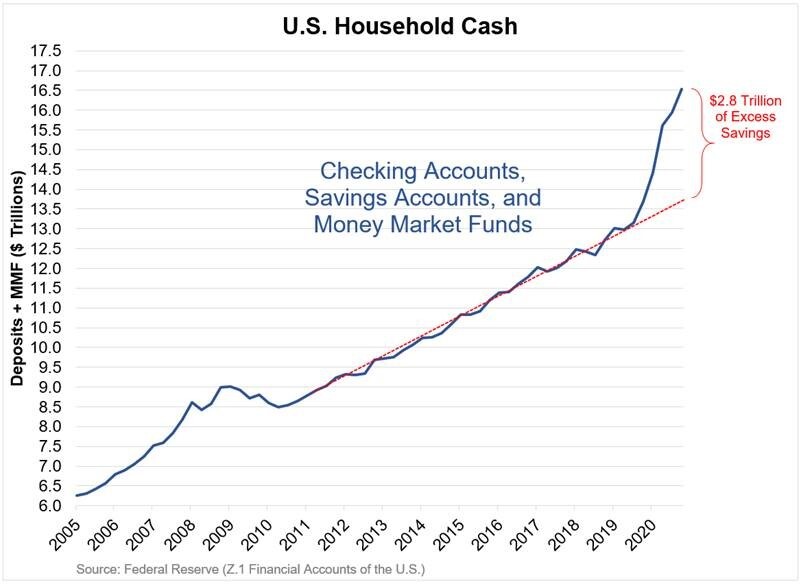
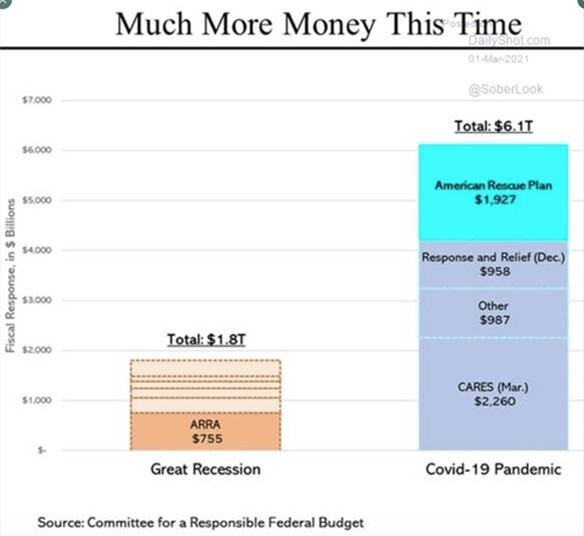
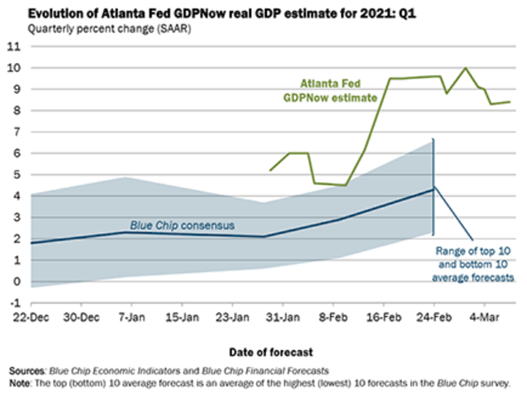
this chart with data from Jefferies Trading Desk makes me think value stocks (including banks) have a lot more room to run, as they’re still in the bottom 20% of their historical valuation range relative to the S&P 500 based on next 12 months’ price-to-earnings (P/E) ratio:

Turbocharged Economy Leaves Factories Struggling to Deliver.
- 03/29/2021 – this crash reminds me the warning from Burry on the danger of over-leveraged market – a surprising chaining reaction – be alert of the danger, try to avoid it and be ready for it
Hedge fund blowup sends shockwaves through Wall Street and the City
Shares in Credit Suisse (CSGN.SW) and Nomura (8604.T) sunk over 10% on Monday after both warned they faced potentially billions in losses linked to hedge fund Archegos Capital.
Hedge funds typically borrow money from banks to invest, a process known as margin trading. This allows funds to leverage up the cash they hold and increase their positions — potentially earning far greater returns if their bets come good. However, it also means hedge funds can theoretically lose more money than they hold in client funds.
If trades made on margin turn sour, banks will ask a client to put up more money as collateral to limit potential losses. This process is known as a margin call.
Archegos faced margin calls on its positions last week but failed to provide extra cash. As a result, banks began selling off stocks held on the hedge fund’s behalf — a fire sale known in the City as liquidating positions. The business press reported on Friday that Goldman Sachs (GS) and Morgan Stanley (MS) were selling huge chunks of shares in businesses including ViacomCBS (VIAC), Discovery (DISCA) and Chinese stocks Baidu (BIDU) and Tencent Music (TME). The block sales are estimated to be worth around $20bn (£14.5bn), according to the Financial Times.
“Things started going wrong for Archegos when shares of companies such as Viacom started to slide mid-last week,” said Michael Brown, a senior market analyst at Caxton Business. “It was at that point that margins were called, and couldn’t be provided, hence the block sales seen Friday.”
- 03/28/2021 – when economy is reopening, it might be good to invest in things like travel companies, restaurants, off-line shopping and “consumer experiences.”
Funds bet on a consumer boom to rival ‘Roaring Twenties’
Some of the world’s top money managers are betting on a post-pandemic spending boom that will boost real-world companies as economies reopen and people go back to their normal lives.
Investors from Aberdeen Standard Investments Inc. and GAM Investments to UBS Asset Management are increasingly pouring money into companies where face-to-face interaction is the norm — things like travel companies, restaurants, off-line shopping and “consumer experiences.”
- 03/25/2021 – Biden to announce details of $3T infrastructure plan on March 31 in Pittsburgh. Good for economy and energy and financial?
Biden to unveil multi-trillion dollar infrastructure plan in Pittsburgh next week
President’s infrastructure bill is expected to include tax hikes on wealthy Americans, corporations
President Biden said Thursday that he will travel to Pittsburgh next week to announce details of his multitrillion-dollar infrastructure bill, a sweeping measure that’s expected to include funds for roads and bridges, as well as address issues like climate change and income inequality.
“The next major initiative is – and I’ll be announcing it Friday in Pittsburgh in detail – is to rebuild the infrastructure, both the physical and technological infrastructure of this country so that we can compete and create significant numbers of really good-paying jobs,” Biden said during his first official White House press conference.
White House press secretary Jen Psaski said Wednesday Biden would provide more details about the proposal on Wednesday, March 31, in Pittsburgh.
The specific contours of the next big-ticket spending package are still unclear, but the measure is widely expected to include a slew of taxes hikes, including raising the corporate tax rate to 28% from 21%, increasing the income tax rate on individuals earning more than $400,000, expanding the estate tax, creating a higher capital-gains tax rate for individuals earning at least $1 million annually and paring back tax preferences for so-called pass-through businesses.
- 03/22/2021 – more to come on infrastructural plan. Mr. Biden is expected to discuss his agenda during his first formal news conference Thursday and in his first address to a joint session of Congress in the coming weeks.
White House eyes sweeping $3T spending proposal
A source familiar with the plans confirmed that administration officials are eyeing $3 trillion as the topline figure for its Build Back Better jobs and infrastructure proposal, though they cautioned talks are fluid and the final number could change. The sweeping package would constitute the White House’s follow-up to the $1.9 trillion economic relief measure signed into law earlier this month.
The new package is expected to be split into two separate bills. The first would focus on infrastructure, with spending on manufacturing and climate change measures, broadband and 5G, and the nation’s roads and bridges.
The other measure would include funds for pre-K programs, free community college tuition, child tax credits and health care subsidies, according to multiple reports.
The White House declined to confirm details of the proposal, saying nothing had been finalized.
Buttigieg’s Next Job: Selling $3 Trillion Infrastructure Plan to Skeptics – WSJ
‘When it comes to rail, why should Texas be inferior to China?’ asks former presidential candidate amid Republican resistance to funding for mass transit
Biden Administration Officials Put Together $3 Trillion Economic Plan – WSJ
President is expected to be briefed on the details of the multipart package this week
Mr. Biden is expected to discuss his agenda during his first formal news conference Thursday and in his first address to a joint session of Congress in the coming weeks.
- 03/21/2021 – Fed might be forced to increase interest rate by the end of 2022
Fed may hike rates sooner than 2023: NABE
The Federal Reserve has been targeting a range of 0.0%-0.25% for the federal funds rate since March 15, 2020
The National Association for Business Economics’ (NABE) March 2020 Economic Policy survey finds that almost half of respondents believe the Federal Reserve could tighten its monetary policy by the end of 2022. The survey, conducted between Feb. 22 and March 5, is a summary of the responses of NABE’s 205 members.
- 02/22/2021 – take time to understand this
https://seekingalpha.com/article/4407906-treasury-yield-stress-point
-
- 03/16/2021 – Sales slipped in February but are set to rebound strongly in March
Spending Is About to Spring Forward – WSJ
Sales slipped in February but are set to rebound strongly in March
Retail sales took a big step back in February. The next step almost inevitably will be a big one forward, but it is what comes after that that will matter most.
The Commerce Department on Tuesday reported that retail sales dropped 3% in February from January, which was more than the modest decline economists had expected. On the other hand, January’s sales jump was revised to an increase of 7.6% from a gain of 5.3%.
The causes of the zig and zag in sales aren’t hard to figure out. January sales were boosted by the government payments that began to arrive in late December. The fading of that boost would already have been a drag on February sales, and then winter storms hit, including the one that left millions of people in Texas without power.
Credit-card data from Bank of America and JPMorgan Chase show that sales so far this month already rebounded from February—and that is before the next set of government payments which are now on the verge of hitting many Americans’ bank accounts. Throw in the arrival of warmer weather that makes pandemic workarounds easier as well as the general sense of relief that the end of the Covid-19 crisis may be in sight, and March retail sales could be quite strong.
-
- 03/16/2021 – Regarding infrastructure plan Democrats want to pass a bill out of committee by Memorial Day and get a bill to Biden by September, though Congress is under pressure to move faster. So we might need to wait half a year on this.
Dems’ momentum hits quagmire over infrastructure plans
Democrats are facing big headaches as they try to craft a sweeping infrastructure and jobs package.
Fresh off a victory on the coronavirus relief bill, where they eschewed GOP support, President Biden and congressional leaders are homing in on one of Washington’s biggest legislative white whales as their next legislative priority.
The goal could test Democratic unity due to razor-thin margins in both chambers and early signs of contention over how to pay for the spending, including talk of a tax hike, and whether the bill should be narrowed in order to make it bipartisan.
Democrats want to pass a bill out of committee by Memorial Day and get a bill to Biden by September, though Congress is under pressure to move faster. It’s unlikely the White House would unveil its plan this month as officials take a victory lap on the COVID-19 relief bill and juggle a burgeoning border crisis.
Transportation Secretary Pete Buttigieg declined to specify a timeline Monday but told reporters that Biden would release an infrastructure proposal “in short order.”
“We’ve got a clock on everything we’re doing, especially because the present surface reauthorization is up in September. We’re not waiting until September in order to act. Conversations are taking place right now, as you’ve seen, Oval Office meetings with the president and leaders from both parties from both houses,” Buttigieg said.
The White House has said that Biden would like to move forward in a bipartisan fashion on infrastructure legislation, but it has not ruled out pursuing the budget reconciliation process.
-
- 03/15/2021 – Historically, the T-Bill/10yr Treas rate spread has followed the same pattern since we have the rate record. The relationship in the T-Bill/10yr Treas rate spread has been a good market indicator. 2018-2019 was unusual in that the T-Bill/10yr Treas rate spread collapsed without recession due to issues with foreign autocrats forcing capital into the US 10yr Treasury for safety which resulted in an inverted yield curve yet no recession till COVID lockdowns. The T-Bill/10yr Treas rate spread still remains a decent indicator of market speculation. – It seems like David Tepper took advantage of this and made a lot of money in QQQ calls. With market psychology and the ever presence of unpredictable geopolitical events, predictions of this type have little precision. Simply, the next inverted yield curve will likely be the market peak. Along the way, investors will speculate in one theme or another. Using past measures of market psychology and fundaments suggests an SP500 peak of $6,000+ in 3yr-5yr. This estimate comes from the SP500 Value Investor Index.- market might still have some runway up for the the time being. Watch out for the inverted yield curve.
How high a market can climb in any cycle has many inputs all ending in peak enthusiasm at the time, i.e. “Market Psychology”. Everyone will have a reason why markets will not peak at the top, but the historical factor which has helped to time peaks since 1953 is the T-Bill/10yr Treas rate spread.
It works if one treats rates as reflecting investor psychology.
- Market Pessimism = Lower Rates
- Market Optimism = Higher Rates
Market pricing is fluid. Very fluid! Highly dependent on conditions leading up to peaks and especially tied to unexpected events. COVID as just experienced was one of these. Historically, the T-Bill/10yr Treas rate spread has followed the same pattern since we have the rate record. During recessions pessimism is high and rates across the yield curve are low. Typically, fear is so high that 10yr rates fall below that of T-Bills. This is called an “Inverted Yield Curve”. Gradually, some investors envision equity opportunities and sell a portion of their 10yr Treasuries to buy equities. The effect results in 10yr Treas rates rising with a rise in equity indices. Over time other investors follow suit. The widening spread of the T-Bill/10yr Treas rate spread reflects improved optimism and also stimulates bank lending with higher net income margins. As the business cycle gains momentum investors begin to shift ever more capital into equities causing both T-Bill and 10yr Treas rates to rise with the pace of 10yr Treas being higher. Further along in the cycle, investor optimism causes capital from T-Bills to enter equities as well creating a period when short and longer term rates rise in parallel. Speculation begins in earnest when the T-Bill/10yr Treas rate spread is 2.0% level. Still further in the cycle optimism overpowers any caution and speculation begins as T-Bill/10yr Treas rate spread begins to narrow. At market peaks, speculation is high and the T-Bill/10yr Treas rate spread has narrowed to 0.2% levels which causes bank lending to fall sharply. What follows is a collapse of speculation without additional lending. A recession follows, investors panic and rates fall sharply across the yield curve. After roughly 18mos of financial restructuring, default and write-offs, the next cycle begins anew.
The relationship in the T-Bill/10yr Treas rate spread has been a good market indicator. 2018-2019 was unusual in that the T-Bill/10yr Treas rate spread collapsed without recession due to issues with foreign autocrats forcing capital into the US 10yr Treasury for safety which resulted in an inverted yield curve yet no recession till COVID lockdowns. The T-Bill/10yr Treas rate spread still remains a decent indicator of market speculation.
Currently the T-Bill/10yr Treas rate spread is widening. The US economy is in a strong recovery outside of government lockdowns. Lockdowns are being eased every week. Employment is recovering, retail, housing, manufacturing and other indicators reflect a “V” shaped recovery. Market have always risen with these conditions and are expected to do so this time as well. Economic activity and the equity markets are likely to peak once we approach an “Inverted Yield Curve” condition. Using past measures of market psychology and fundaments suggests an SP500 peak of $6,000+ in 3yr-5yr. This estimate comes from the SP500 Value Investor Index.
With market psychology and the ever presence of unpredictable geopolitical events, predictions of this type have little precision. Simply, the next inverted yield curve will likely be the market peak. Along the way, investors will speculate in one theme or another. COVID provided a focus which is now ending as seen in the correction of VOOG(SP500Growth ETF). The VOOV(SP500 Value RTF) is gaining investor interest. COVID is behind us and VOOV is very likely to out-perform VOOG for the next few years.
For now, markets remain in an uptrend as ~8mil-9mil currently unemployed individuals return to work. The sharp rise in the T-Bill/10yr Treas rate spread indicates a sharp rise in investor optimism. Current levels indicate much more is yet to come.
- 03/14/2021 – In order to fight the high inflation in 1965 to 1982, Fed tightened money and raised interest rate to slow down economy, but drove unemployment very high. Eventually, inflation dropped and unemployment dropped
The Great Inflation: 1965–1982
The Great Inflation was the defining macroeconomic period of the second half of the twentieth century. Lasting from 1965 to 1982, it led economists to rethink the policies of the Fed and other central banks.
Sections
- Forensics of the Great Inflation
- The Motive: The Phillips Curve and the Pursuit of Full Employment
- The Means: The Collapse of Bretton Woods
- The Opportunity: Fiscal Imbalances, Energy Shortages, and Bad Data
- From High Inflation to Inflation Targeting—The Conquest of US Inflation
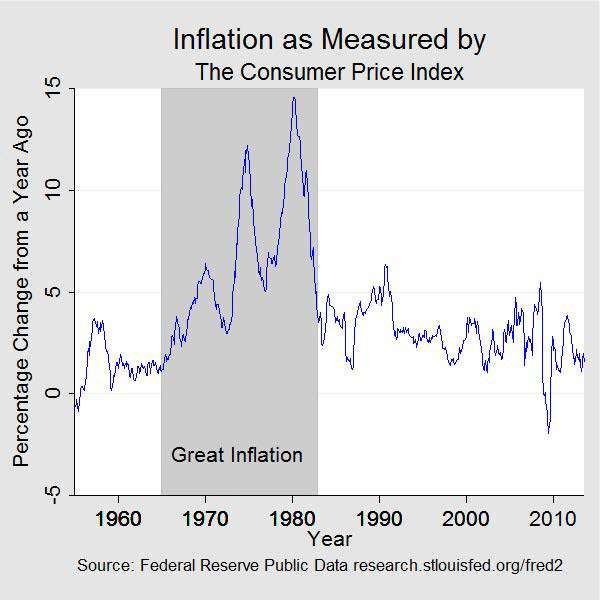
The Federal Reserve after World War II
Lecture Materials: details on inflation
The Federal Reserve after World War II presentation (PDF) | Accessible Version
- 03/14/2021 – Yellen admits that we will have inflation which is manageable according to the 1970s as an important lesson. However, during this period, interest rates hit nearly 20% due to government policies, economy tanked, unemployment sky high. Only eventually, inflation died out. The cost was significant. see the history here (The Federal Reserve after World War II presentation (PDF))
Yellen projects full employment in 2022, interest rates to remain low
Yellen believes the Fed has learned lessons from high inflation during the 1970s
Treasury Secretary Janet Yellen believes that 2022 will see a return to full employment, crediting the race.
A rapid rise in employment may have a knock-on effect of creating rampant inflation. Yellen downplayed those concerns, though, calling it a “small risk” that is manageable.
“Prices fell a lot last spring when the pandemic surged. I expect some of those prices to move up again as the economy recovers in spring and summer,” Yellen explained. “That’s a temporary movement in prices.”
Yellen cited the 1970s as an important lesson, when interest rates hit nearly 20% due to government policies. The Federal Reserve has “learned” to manage expectations, and Yellen believes that the government has the tools to handle rising inflation – should it occur.
Further, the world’s trends appear to be in support of low interest rates: Yellen pointed to lower interest rates in years prior to the pandemic – trends she believes will continue even after the country recovers.
- 03/12/2021 – inflation is a process. The interplay between inflation and the bond market isn’t so different — yields lead growth, growth leads inflation, and inflation catches up last. “The real inflation story begins when the labor market fully heals,” Dutta adds. “The economy remains far from this point. Indeed, this year will likely bring with it a significant positive supply shock in the labor market as schools reopen.”
‘Inflation is a process’ Inflation might be coming. The data says: not yet.
In financial markets there are few things you can count on.
But one thing we know will surely come up sooner rather than later are widespread concerns about inflation.
The commodities cycle, the Treasury yield curve, growth forecasts, and easy comps all suggest that higher consumer prices are coming down the pike this year. Which made Wednesday’s report from the BLS on consumer prices hotly anticipated by investors.
When the numbers dropped, however, they landed with a bit of a thud. At least if you were expecting to see inflation starting to take off.
In a recent note, we saw one strategist note that the stock market leads earnings, earnings lead the economy, and economic growth catches up last. The interplay between inflation and the bond market isn’t so different — yields lead growth, growth leads inflation, and inflation catches up last.
In the summer, additional re-opening alongside easing supply chain pressures will likely result in pockets of inflation but not broad overall price pressures. Another look-through from the Fed’s perspective.
“The real inflation story begins when the labor market fully heals,” Dutta adds. “The economy remains far from this point. Indeed, this year will likely bring with it a significant positive supply shock in the labor market as schools reopen.”
And so we should expect plenty of fireworks on inflation data in the coming months, though none of this is likely to give the Fed any reason to change its forecasts. Even if — or perhaps especially if — the numbers might appear to suggest otherwise.
- 03/12/2021 – Biden admin’s next plan might be trillion-dollar infrastructure and clean-energy jobs package. Some Dems think it is better to also include health care and immigration reform, but some think it might be too much to get passed. The new package might come as early as May and final passage might not happen until the fall. Dem does not want to wait for 2022 because of the mid-term election. Dem wants to have bipartisan plan, even without it, they want to have good faith through reconciliation. – we will see what will happen.
Democrats debate fast-track for infrastructure package
fresh off his first major legislative victory, Biden himself says his nascent administration will turn next to a trillion-dollar infrastructure and clean-energy jobs package. And a growing number of Democrats are now urging the White House and Democratic leadership to use the special budget process to push it through the Congress to deliver critical roads, bridges and broadband projects to their districts and a potent campaign issue they can run on in the tough 2022 midterms.
“We need an FDR-like investment in our infrastructure,” Rep. Rick Larsen (D-Wash.), chair of the Transportation and Infrastructure (T&I) aviation subcommittee, told The Hill.
Yarmuth called infrastructure the “No. 1 priority for using reconciliation if we have to,” for both the Biden administration and congressional Democrats.
If talks with Republicans fall apart over the next two months, Yarmuth said, Democrats could begin the reconciliation process — passing another budget bill directing committees to draft individual pieces of the package — as early as May, shortly after Biden sends his fiscal 2022 budget request to Congress.
Final passage might not happen until the fall, Yarmuth said.
Still, there is reluctance in the party to a go-it-alone approach on infrastructure, a rare issue that polls well on both sides of the aisle. Centrist Sen. Joe Manchin (D-W.Va.) has threatened to derail Biden’s infrastructure package unless a serious effort is made to bring Republicans on board.
“I am not going to get on a bill that cuts them out completely before we start trying,” Manchin told Axios recently.
- 03/11/2021 – Gates and Buffett use farmland to fight against low interest rate and future possible hyperinflation? lots of fed subsid
Congress has reduced risk by underwriting crop prices and cash revenues
Bill Gates is now the largest owner of farmland in the U.S. having made substantial investments in at least 19 states throughout the country. He has apparently followed the advice of another wealthy investor, Warren Buffett, who in a February 24, 2014 letter to investors described farmland as an investment that has “no downside and potentially substantial upside.”
There is a simple explanation for this affection for agricultural assets. Since the early 1980s, Congress has consistently succumbed to pressures from farm interest groups to remove as much risk as possible from agricultural enterprises by using taxpayer funds to underwrite crop prices and cash revenues.
Over the years, three trends in farm subsidy programs have emerged.
- 03/10/2021 – Extending this relief could bring calm to anxious markets, and the Fed may consider it good housekeeping for monetary policy or Treasury-market functioning—though it might also be politically costly, as some top Democrats oppose extension. But it is unlikely to be a cure for rising rates in general.
Bank Regulation Tweak Unlikely to Be Cure-All for Treasurys – WSJ
Extending a pandemic rule enabling banks to hold more Treasurys may have a limited impact on rising yields
The latest example is whether or not the Federal Reserve will extend an emergency pandemic policy to exclude cash and Treasurys from banks’ supplementary leverage ratios, a key regulatory measure. Doing so would give them more capacity to gather deposits and buy government bonds. If the Fed doesn’t extend this after it is set to expire on March 31, the argument goes, there might be even more upward pressure on yields in the Treasury market.
Extending this relief could bring calm to anxious markets, and the Fed may consider it good housekeeping for monetary policy or Treasury-market functioning—though it might also be politically costly, as some top Democrats oppose extension. But it is unlikely to be a cure for rising rates in general.
- 03/10/2021 – watch out the Fed supply of treasury bonds, too much again will push down yield a lot. So far might be OK because he Treasury Department may not need to increase the amount of notes and bonds it issues to fund the $1.9 trillion coronavirus relief package that President Biden is expected to sign shortly, analysts said, given its cash on hand and the size of current auctions.
Flood of New Debt Tests Bond Market – WSJ
Supply seen as one factor driving yields higher as investors anticipate economic resurgence fueled by vaccinations and government stimulus
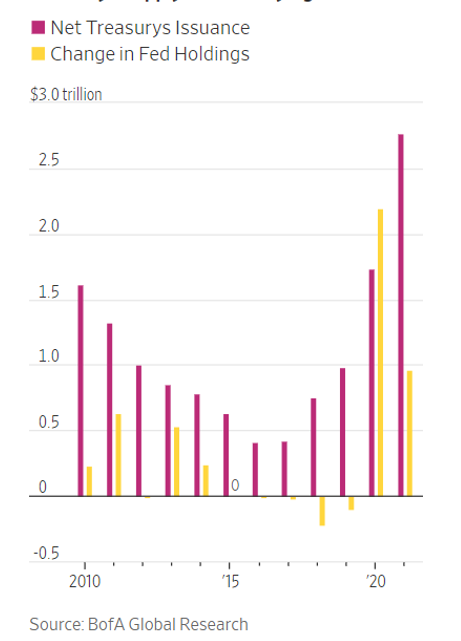
Net new supply of two- to 30-year Treasurys is expected to reach $2.8 trillion this year, according to BofA Global Research, up from $1.7 trillion last year and around $990 billion in 2019. The Fed, meanwhile, is expected to purchase $960 billion of Treasurys, down from more than $2 trillion last year.
Supply may not be the primary factor driving yields higher. But it has been an accelerant, weighing on the market precisely because the economic outlook has already made investors hesitant to buy bonds, traders say.
One piece of good news for investors is that the Treasury Department may not need to increase the amount of notes and bonds it issues to fund the $1.9 trillion coronavirus relief package that President Biden is expected to sign shortly, analysts said, given its cash on hand and the size of current auctions.
- 03/10/2021 – no lock down of economy in 1920s during spanish flu, so America prospered after it
Mainstream inflation consensus and Rosenberg in the 1920s
As Wall Street veteran Bob Farrell pointed out, “if all experts and predictions match, something else will happen,” Rosenberg reminds us.
Rosie, as he is widely known, does not buy a comparison with the big names in the 1920s, nor a comparison with the period after the common Spanish flu.
This time it is different, in his opinion, because of the size of the debt already in the system, there is no prospect of a global boom after overcoming the pandemic.
The main points of Rosenberg’s rationale (his emphasis) are:
For one thing, coming out of World War I, which ended when the Spanish flu began, the United States now accounts for half of the world’s manufacturing production. That’s because the war devastated the entire European economy and gave US industry the opportunity to gain global market share in exports and industrial production.
Second, the United States treated the Spanish flu quite differently. The economy was never completely blocked. People have just learned to live with the disease and eventually disappeared with herd immunity. At that time, no one asked the government for help. It was all about community and philanthropy. These were the days before welfare and unemployment insurance benefits and company bailouts. Public attitudes towards illness and death were very different, and there was no internet or social media that influenced people’s perceptions and aroused emotions.
At that time, the economy collapsed, but the government didn’t bother with the financial scale. As a result, when the crisis ended, in the 1920s, huge demand stagnated and the balance sheet was much better. Government debt to GDP was 10%, not over 100%. And its better public sector balance sheet allowed the federal government to cut taxes by the mid-1920s. The maximum marginal tax rate for businesses was initially raised from 10% in 1920 to 13.5% by 1926, but in 10 years; for individuals, that percentage went from 58% after the war to 24% by 1929. It was. Does anyone think the tax will drop soon in the US?
- 03/10/2021 – the infrastructure plan may got through reconciliation and have to go through bipartisan process since Manchin wants it. So the final approval might take several months. The way to pay for this might be some combination of higher taxes and a deluge of municipal bond sales subsidized by the federal government via direct payments or tax credits. “There is no dispute about how to finance infrastructure — as always, it will be financed via the U.S. municipal market, which has been the cornerstone of U.S. infrastructure financing since the Great Depression and will continue to stay so,” – what can I do with municipal market?
- With President Joe Biden’s Covid stimulus package set to become law, the White House now turns its attention to a once-in-a-generation infrastructure bill.
- During the campaign, Biden pitched a $2 trillion plan that aims to achieve carbon-free power generation by 2035 and creates “millions” of union jobs.
- Infrastructure is a bipartisan issue, but divisions exist between progressive Democrats and a coalition of moderates and Republicans.
- “Do not think of the infrastructure bill as just roads and bridges. Democrats view an infrastructure bill as the ‘infrastructure’ necessary to build the economy of the future,” Raymond James told clients Monday.
The West Virginia senator has also balked at efforts to alter Senate rules that would allow his party to enact its agenda over Republican opposition.
“I’m not going to do it through reconciliation,” Manchin told Axios over the weekend in reference to the infrastructure plan. “I am not going to get on a bill that cuts [the GOP] out completely before we start trying.”
Even if the president shares the left’s ambitious goals, one topic the Biden team has been even less keen to detail is how it plans to pay for such a massive undertaking. The answer is some combination of higher taxes and a deluge of municipal bond sales subsidized by the federal government via direct payments or tax credits.
The trick, of course, is striking the right balance.
Treasury Secretary Janet Yellen and others have offered oblique commentary on future, way-off-on-the-distant-horizon tax hikes. Last month, for example, she was quick to assure CNBC’s viewers that any tax increases to help pay for spending would only be introduced gradually.
“There is no dispute about how to finance infrastructure — as always, it will be financed via the U.S. municipal market, which has been the cornerstone of U.S. infrastructure financing since the Great Depression and will continue to stay so,” Rai told clients Friday.
-
03/08/2021 – Tepper thinks rates have temporarily made the most of the move and should be more stable “in the next few months”, which makes it safer to be in stocks for now. Japan could start buying the U.S. government bonds again following the surge in yields. The potential buying could help stabilize the bond market. Another bullish catalyst for stocks in the near term is the coronavirus fiscal stimulus package. Tech stocks like “bellwether” stocks like Amazon are starting to look attractive after the pullback.
David Tepper is getting bullish on stocks, believes rising rates are set to stabilize
- Tepper, founder of Appaloosa Management, said it’s very difficult to be bearish on stocks right now.
- He thinks the sell-off in Treasurys that has driven rates higher is likely over.
David Tepper, founder of Appaloosa Management whose comments have been known to move markets, said it’s very difficult to be bearish on stocks right now and thinks the sell-off in Treasurys that has driven rates higher is likely over.
The major market risk has been removed, Tepper said, adding that rates should be more stable in the short term.
“Basically I think rates have temporarily made the most of the move and should be more stable in the next few months, which makes it safer to be in stocks for now,” Tepper told CNBC’s Joe Kernen, who shared the comments on “Squawk Box.”
Tepper believes Japan, which had been a net seller of Treasurys for years, could start buying the U.S. government bonds again following the surge in yields. The potential buying could help stabilize the bond market, Tepper said.
“That takes a major risk off the table, and it’s very difficult to be bearish,” Tepper told Kernen.
Another bullish catalyst for stocks in the near term is the coronavirus fiscal stimulus package that was just approved by the Senate, Tepper said.
The Democrat-controlled House is projected to pass the $1.9 trillion economic relief and stimulus bill later this week. President Joe Biden is expected to sign it into law before unemployment aid programs expire on March 14.
The hedge fund manager also said “bellwether” stocks like Amazon are starting to look attractive after the pullback. Shares of the e-commerce giant have fallen 9.7% over the past month, while Apple has dropped more than 11% during the same period.
- 03/04/2021 – Fed likes to maintain easy-money policies. Powell thinks the inflation is transient only due to reopen of economy, but he forgot to mention about the massive M2 and helicopter money, will we have hyperinflation like Burry speculates?
Powell Confirms Fed to Maintain Easy-Money Policies – WSJ
Fed chairman says economy is far from employment and inflation goals; he gives no sign the central bank would seek to stem rise in Treasury yields
Mr. Powell said it’s “highly unlikely” that the Fed’s goal of maximum employment will be reached this year. But he was less clear about whether the economy could show enough improvement this year for the Fed to start reducing its monthly asset purchases.
“I’ve so far been able to not reduce it to an estimate of time. I mean, that will come, I think, when we can see that,” Mr. Powell said, referring to the standard that the Fed wants to meet before scaling back its asset purchases.
- 03/04/2021 – watch out the infrastructure plan to come?
Biden, Buttigieg Push Infrastructure Plan – WSJ
President, transportation secretary meet House lawmakers to discuss proposal for rebuilding aging roads, dams and railroads
President Biden met Thursday with Republican and Democratic members of the House of Representatives to discuss his plans for an infrastructure package, a goal that has eluded Democratic lawmakers and his Republican predecessor, former President Donald Trump, even as members of both parties and outside groups claim there is bipartisan support for such a measure.
Mr. Biden told reporters at the outset of the Oval Office meeting that the subject of their discussion would be American competitiveness. The group would be talking about “what we’re going to do to make sure we once again lead the world across the board on infrastructure.”
- 03/03/2021 – higher rate might derail the growth of economy. Watch out
Despite The Fed, The Bond Market Is Hiking Rates
The Fed Is Walking Into A Trap: The Fed has a choice. It can watch yields rise to the detriment of economic growth, or it can walk back monetary policy. Doing so requires tapering QE and raising rates. Either action will pose problems for overvalued equity markets based on a tailwind of easy monetary policy.
To put it bluntly, the Fed is walking into a trap where at some point, it will get forced into deciding between rescuing the bond market or the stock market.
Why Higher Rates Are A Problem
It is essential to understand the impact of rates on a heavily leveraged economy.
1) Economic growth is still dependent on massive levels of monetary interventions. An increase in rates curtails growth as rising borrowing costs slows consumption.
2) The Federal Reserve runs the world’s largest hedge fund with over $7.5-Trillion in assets. Long Term Capital Mgmt., which managed only $100 billion, nearly derailed the economy when rising rates caused its collapse. The Fed is 75x that size.
3) Rising interest rates will immediately slow the housing market. People buy payments, not houses, and rising rates mean higher payments.
4) An increase in interest rates means higher borrowing costs which lowers profit margins for corporations.
5) One of the main bullish arguments over the last 11-years remains stocks are cheap based on low interest rates. That will change very quickly.
6) The negative impact on the massive derivatives market could lead to another credit crisis as rate-spread derivatives go bust.
7) As rates increase, so do the variable rate interest payments on credit cards. With the consumer already impacted by stagnant wages, under-employment, and high costs of living; a rise in debt payments would further curtail disposable incomes. Such would lead to a contraction in spending and rising defaults. (Which are already happening as we speak)
8) Rising defaults on the debt will negatively impact banks that are still not adequately capitalized and still burdened by massive levels of bad debt.
9) Commodities, which are sensitive to the direction and strength of the global economy, will revert as economic growth slows.
10) The deficit/GDP ratio will surge as borrowing costs rise sharply. The many forecasts for lower future deficits will crumble as new estimates begin to propel higher.
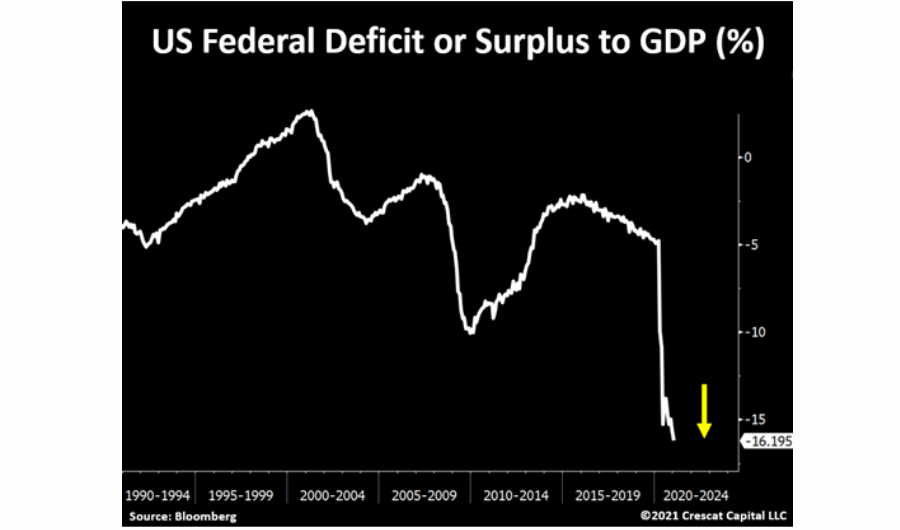
I could go on, but you get the idea.
Currently, the economy requires almost $4.50 in debt to manufacture $1.00 of economic growth. Given the dependence on debt to fund growth, higher interest rates would be inherently destructive.
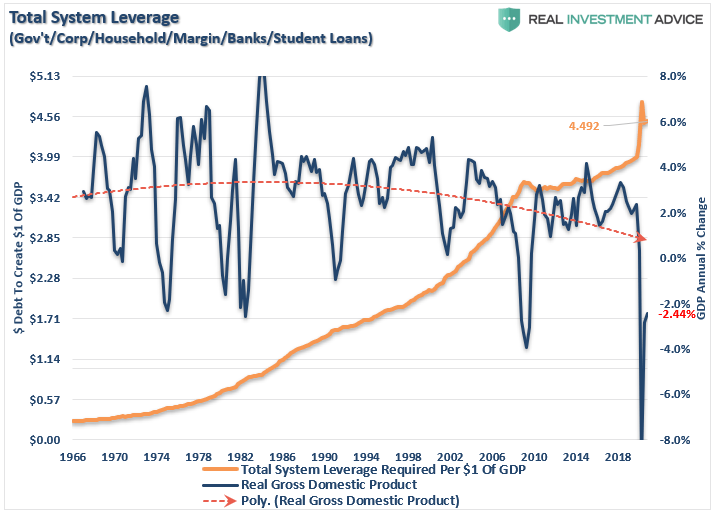
More importantly, consumers have sunk themselves deeper into debt as well. Currently, the gap between wages and the costs of supporting the required “standard of living” is at a record. With a requirement of over $16,000 in debt to maintain living standards, there is little ability to absorb higher rates before it drastically curbs consumption.
The annual deficit of over $4,000 to make up the gap between the cost of living and current incomes increases debt loads on consumers. Higher interest rates will further absorb discretionary incomes into debt service.
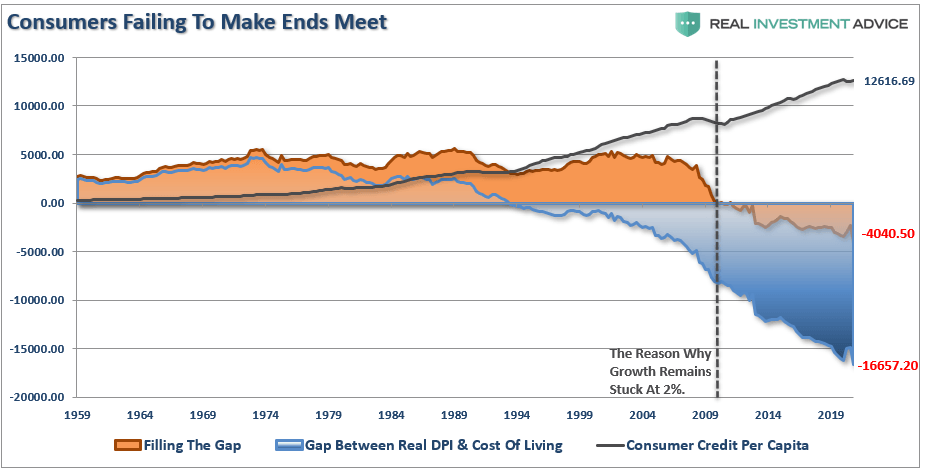
- 03/03/2021 – prepare for more rate rise in the future
More Rate Scares Ahead for Stocks – WSJ
Market selloffs based on fears of higher rates are likely to become a frequent occurrence
If the economy really does improve through the course of the year—an eventuality that, of course, depends on the fight against the pandemic going well—the stock market could be in for a period of general optimism punctuated by panicked, rates-driven selloffs. In other words, the market’s recent displacements could be just a preview of what is to come.
- 03/05/2021 – Chinese government’s annual parliamentary meeting: urbanization, Green, EV, quality vs quantity, high tech
政府工作报告
——2021年3月5日在第十三届全国人民代表大会第四次会议上
创新宏观政策实施方式,对新增2万亿元中央财政资金建立直达机制,省级财政加大资金下沉力度,共同为市县基层落实惠企利民政策及时补充财力。支持银行定向增加贷款并降低利率水平,对中小微企业贷款延期还本付息,大型商业银行普惠小微企业贷款增长50%以上,金融系统向实体经济让利1.5万亿元。对大企业复工复产加强“点对点”服务。
——全面推进乡村振兴,完善新型城镇化战略。坚持农业农村优先发展,严守18亿亩耕地红线,实施高标准农田建设工程、黑土地保护工程,确保种源安全,实施乡村建设行动,健全城乡融合发展体制机制。建立健全巩固拓展脱贫攻坚成果长效机制,提升脱贫地区整体发展水平。深入推进以人为核心的新型城镇化战略,加快农业转移人口市民化,常住人口城镇化率提高到65%,发展壮大城市群和都市圈,推进以县城为重要载体的城镇化建设,实施城市更新行动,完善住房市场体系和住房保障体系,提升城镇化发展质量。
——优化区域经济布局,促进区域协调发展。深入实施区域重大战略、区域协调发展战略、主体功能区战略,构建高质量发展的区域经济布局和国土空间支撑体系。扎实推动京津冀协同发展、长江经济带发展、粤港澳大湾区建设、长三角一体化发展、黄河流域生态保护和高质量发展,高标准、高质量建设雄安新区。推动西部大开发形成新格局,推动东北振兴取得新突破,促进中部地区加快崛起,鼓励东部地区加快推进现代化。推进成渝地区双城经济圈建设。支持革命老区、民族地区加快发展,加强边疆地区建设。积极拓展海洋经济发展空间。
——全面深化改革开放,持续增强发展动力和活力。构建高水平社会主义市场经济体制,激发各类市场主体活力,加快国有经济布局优化和结构调整,优化民营经济发展环境。建设高标准市场体系,全面完善产权制度,推进要素市场化配置改革,强化竞争政策基础地位,完善竞争政策框架。建立现代财税金融体制,提升政府经济治理能力。深化“放管服”改革,构建一流营商环境。建设更高水平开放型经济新体制,推动共建“一带一路”高质量发展,构建面向全球的高标准自由贸易区网络。
——推动绿色发展,促进人与自然和谐共生。坚持绿水青山就是金山银山理念,加强山水林田湖草系统治理,加快推进重要生态屏障建设,构建以国家公园为主体的自然保护地体系,森林覆盖率达到24.1%。持续改善环境质量,基本消除重污染天气和城市黑臭水体。落实2030年应对气候变化国家自主贡献目标。加快发展方式绿色转型,协同推进经济高质量发展和生态环境高水平保护,单位国内生产总值能耗和二氧化碳排放分别降低13.5%、18%。
三、2021年重点工作
今年是我国现代化建设进程中具有特殊重要性的一年。做好政府工作,要在以习近平同志为核心的党中央坚强领导下,以习近平新时代中国特色社会主义思想为指导,全面贯彻党的十九大和十九届二中、三中、四中、五中全会精神,坚持稳中求进工作总基调,立足新发展阶段,贯彻新发展理念,构建新发展格局,以推动高质量发展为主题,以深化供给侧结构性改革为主线,以改革创新为根本动力,以满足人民日益增长的美好生活需要为根本目的,坚持系统观念,巩固拓展疫情防控和经济社会发展成果,更好统筹发展和安全,扎实做好“六稳”工作、全面落实“六保”任务,科学精准实施宏观政策,努力保持经济运行在合理区间,坚持扩大内需战略,强化科技战略支撑,扩大高水平对外开放,保持社会和谐稳定,确保“十四五”开好局起好步,以优异成绩庆祝中国共产党成立100周年。
今年我国发展仍面临不少风险挑战,但经济长期向好的基本面没有改变。我们要坚定信心,攻坚克难,巩固恢复性增长基础,努力保持经济社会持续健康发展。
今年发展主要预期目标是:国内生产总值增长6%以上;城镇新增就业1100万人以上,城镇调查失业率5.5%左右;居民消费价格涨幅3%左右;进出口量稳质升,国际收支基本平衡;居民收入稳步增长;生态环境质量进一步改善,单位国内生产总值能耗降低3%左右,主要污染物排放量继续下降;粮食产量保持在1.3万亿斤以上。
经济增速是综合性指标,今年预期目标设定为6%以上,考虑了经济运行恢复情况,有利于引导各方面集中精力推进改革创新、推动高质量发展。经济增速、就业、物价等预期目标,体现了保持经济运行在合理区间的要求,与今后目标平稳衔接,有利于实现可持续健康发展。
今年要重点做好以下几方面工作。
(一)保持宏观政策连续性稳定性可持续性,促进经济运行在合理区间。在区间调控基础上加强定向调控、相机调控、精准调控。宏观政策要继续为市场主体纾困,保持必要支持力度,不急转弯,根据形势变化适时调整完善,进一步巩固经济基本盘。
(二)深入推进重点领域改革,更大激发市场主体活力。在落实助企纾困政策的同时,加大力度推动相关改革,培育更加活跃更有创造力的市场主体。
深化财税金融体制改革。强化预算约束和绩效管理,加大预算公开力度,精简享受税费优惠政策的办理流程和手续。落实中央与地方财政事权和支出责任划分改革方案。健全地方税体系。继续多渠道补充中小银行资本、强化公司治理,深化农村信用社改革,推进政策性银行分类分账改革,提升保险保障和服务功能。稳步推进注册制改革,完善常态化退市机制,加强债券市场建设,更好发挥多层次资本市场作用,拓展市场主体融资渠道。强化金融控股公司和金融科技监管,确保金融创新在审慎监管的前提下进行。完善金融风险处置工作机制,压实各方责任,坚决守住不发生系统性风险的底线。金融机构要坚守服务实体经济的本分。
(三)依靠创新推动实体经济高质量发展,培育壮大新动能。促进科技创新与实体经济深度融合,更好发挥创新驱动发展作用。
提升科技创新能力。优化和稳定产业链供应链。继续完成“三去一降一补”重要任务。对先进制造业企业按月全额退还增值税增量留抵税额,提高制造业贷款比重,扩大制造业设备更新和技术改造投资。增强产业链供应链自主可控能力,实施好产业基础再造工程,发挥大企业引领支撑和中小微企业协作配套作用。发展工业互联网,促进产业链和创新链融合,搭建更多共性技术研发平台,提升中小微企业创新能力和专业化水平。加大5G网络和千兆光网建设力度,丰富应用场景。加强网络安全、数据安全和个人信息保护。统筹新兴产业布局。加强质量基础设施建设,深入实施质量提升行动,完善标准体系,促进产业链上下游标准有效衔接,弘扬工匠精神,以精工细作提升中国制造品质。
(四)坚持扩大内需这个战略基点,充分挖掘国内市场潜力。紧紧围绕改善民生拓展需求,促进消费与投资有效结合,实现供需更高水平动态平衡。
稳定和扩大消费。多渠道增加居民收入。健全城乡流通体系,加快电商、快递进农村,扩大县乡消费。稳定增加汽车、家电等大宗消费,取消对二手车交易不合理限制,增加停车场、充电桩、换电站等设施,加快建设动力电池回收利用体系。发展健康、文化、旅游、体育等服务消费。鼓励企业创新产品和服务,便利新产品市场准入,推进内外贸产品同线同标同质。保障小店商铺等便民服务业有序运营。运用好“互联网+”,推进线上线下更广更深融合,发展新业态新模式,为消费者提供更多便捷舒心的服务和产品。引导平台企业合理降低商户服务费。稳步提高消费能力,改善消费环境,让居民能消费、愿消费,以促进民生改善和经济发展。扩大有效投资。
(五)全面实施乡村振兴战略,促进农业稳定发展和农民增收。接续推进脱贫地区发展,抓好农业生产,改善农村生产生活条件。
(六)实行高水平对外开放,促进外贸外资稳中提质。实施更大范围、更宽领域、更深层次对外开放,更好参与国际经济合作。
高质量共建“一带一路”。坚持共商共建共享,坚持以企业为主体、遵循市场化原则,健全多元化投融资体系,强化法律服务保障,有序推动重大项目合作,推进基础设施互联互通。提升对外投资合作质量效益。
(七)加强污染防治和生态建设,持续改善环境质量。深入实施可持续发展战略,巩固蓝天、碧水、净土保卫战成果,促进生产生活方式绿色转型。
(八)切实增进民生福祉,不断提高社会建设水平。注重解民忧、纾民困,及时回应群众关切,持续改善人民生活。
保障好群众住房需求。坚持房子是用来住的、不是用来炒的定位,稳地价、稳房价、稳预期。解决好大城市住房突出问题,通过增加土地供应、安排专项资金、集中建设等办法,切实增加保障性租赁住房和共有产权住房供给,规范发展长租房市场,降低租赁住房税费负担,尽最大努力帮助新市民、青年人等缓解住房困难。
- 03/03/2021 – China will have a good growth strategy, GDP might grow up to 7% in year 2021, good for global economy.
China prepares for a big annual meeting to chart a growth strategy
- The Chinese government’s annual parliamentary meeting known as the “Two Sessions” is set to kick off this week in Beijing.
- The otherwise generally symbolic gathering takes on particular significance this year as it marks the beginning of China’s five-year development plan — the 14th such in the country’s history — and the 100th anniversary of the ruling Communist Party.
- Authorities are also set to lay out targets for this year’s urban job creation, inflation and other growth measures
Most economists do not expect authorities will release a GDP target this year, after making a rare decision not to do so at last year’s parliamentary meeting, which was delayed by about two months due to the coronavirus pandemic.
Li-Gang Liu, managing director and chief China economist at Citi Research, said in a note that if the report lays out a GDP target directly or indirectly, the figure could top 7%. That’s according to growth goals announced by different Chinese provinces and a commitment to double GDP from its level in 2010, Liu said.
- 03/02/2021 – China warns of real-estate bubble and global financial bubble
China Banking Regulator Sees Risk From ‘Bubble’ in Real-Estate Prices – WSJ
Guo Shuqing also says global financial markets are out of sync with real-world economic conditions
Guo Shuqing, chairman of the China Banking and Insurance Regulatory Commission, told reporters in a briefing Tuesday that he was concerned about what he called a “bubble” in Chinese real-estate prices, which he said could threaten the country’s financial sector and its broader economy.
“Many people buy homes not to live in, but to invest or speculate. This is very dangerous,” said Mr. Guo, comparing the property bubble to a “gray rhino”—an obvious but neglected threat.
Mr. Guo also warned about the possibility of spillover from what he described as asset bubbles in global financial markets, which he added were out of sync with real-world economic conditions. He said Beijing was studying measures to manage capital inflows in a way that would prevent any global turbulence from hitting domestic financial markets without discouraging foreign investment.
- 03/02/2021 – This month fed might redo Operation Twist, in which the Fed sells short-term bills and buys longer-duration bonds. This will drive down the 10 year treasury yield. The moves would be to address market stability rather than economic concerns.
Guggenheim’s Minerd says don’t count on rising yields, believes U.S. could even see negative rates
- Guggenheim’s Scott Minerd said the widespread expectation for a continued rise in interest rates was likely wrong, based on historical trends.
- “Whether it’s negative rates or rates which are barely positive, I think that over the course of the next 18 months, we should expect to see a high likelihood that we end up with significantly lower long-term rates than we have today,” Minerd said.
- A recent climb in Treasury yields picked up steam last week, with the benchmark 10-Year yield trading well above 1.5% and briefly piercing 1.6%
Fed policy changes could be coming in response to bond market turmoil, economists say
- The Federal Reserve could have two policy tweaks in store as soon as this month, investors and economists say.
- One would see a rebirth of Operation Twist, in which the Fed sells short-term bills and buys longer-duration bonds.
- Others could see an increase in rates on excess reserves and overnight repo operations.
- The moves would be to address market stability rather than economic concerns.
- 03/02/2021 – the V-recovery is getting accelerated?
10% GDP growth? The U.S. economy is on fire, and is about to get stoked even more
- Economic growth in the first quarter could hit 10%, according to a Federal Reserve tracker.
- That comes amid Congress poised to spend another $1.9 trillion to address various areas.
- Manufacturing is at its highest level since 2018, with prices rising and inventories choked.
- Employment remains the main weak spot, though some encouraging signs are emerging.
“With strong federal fiscal support and continued progress on vaccination, GDP growth this year could be the strongest we’ve seen in decades,” New York Federal Reserve President John Williams said in a speech last week.
- 03/01/2021 – Mr. Summers said today’s economists are too quick to conclude from recent decades that low unemployment is no longer inflationary. He said unemployment hasn’t stayed low long enough to prove that, because when unemployment dropped to low levels, the Fed usually responded by raising rates and causing a recession.
Is Inflation a Risk? Not Now, but Some See Danger Ahead – WSJ
Though slack in the economy and a vigilant Fed currently keep prices well in check, some economists say political pressure and new emphasis on maximizing employment could test central bank’s resolve
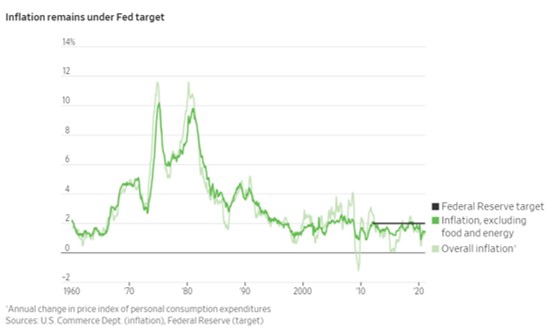
Mr. Summers and Mr. Blanchard see worrying parallels to the 1960s. President John Kennedy’s advisers at the start of the decade were right to think fiscal policy could push unemployment lower without inflation, Mr. Summers said. “It’s just that the idea got taken to political excess [under President Lyndon Johnson] with ‘guns and butter,’ ” he added. Unemployment went below 4% in 1966, and inflation, which had been below 2% since 1960, jumped to 5% in 1969.
Mr. Summers said today’s economists are too quick to conclude from recent decades that low unemployment is no longer inflationary. He said unemployment hasn’t stayed low long enough to prove that, because when unemployment dropped to low levels, the Fed usually responded by raising rates and causing a recession.
Both Fed and Biden administration officials are confident that central banks have learned from the 1960s and 1970s and won’t repeat those mistakes. And while the Fed has limited ability to cut rates when inflation is low, it can raise them as much as needed when inflation is high.
Jared Bernstein, a member of Mr. Biden’s Council of Economic Advisers, said the administration believes the risks of high and persistent unemployment, hunger, eviction and other fallout from Covid-19 without stimulus outweigh the risks of inflation with stimulus. That doesn’t mean that the risk of inflation is zero. “It does mean we have a central bank laser-focused on maintaining anchored inflation expectations to guard against that risk,” he said.
The Fed has said it would start raising interest rates from around zero only when inflation is 2% and likely to stay above that, and the U.S. is at maximum employment.
- 03/01/2021 – The likely passage of a stimulus package on Capitol Hill may give a nice short-term boost to the stock market, but the worries about the long-ranging ramifications when the bills come due from the multiple coronavirus-driven stimulus packages may continue to fuel inflation worries. Recommend value names, in the financial and industrial groups, as well as sectors that will likely benefit from President Biden’s more environmentally friendly policies.
Stock Market Today: March 1, 2021
So what will investors be focusing on in the week ahead? The five-day stretch will start with attention on another coronavirus stimulus package—it passed in the House of Representatives, but now goes up for debate in the Senate—and the aforementioned approval of the Johnson & Johnson (JNJ) coronavirus vaccine. The likely passage of a stimulus package on Capitol Hill may give a nice short-term boost to the stock market, but the worries about the long-ranging ramifications when the bills come due from the multiple coronavirus-driven stimulus packages may continue to fuel inflation worries. Against this backdrop, we continue to recommend that investors look at the value names, particularly in the financial and industrial groups, which underperformed in 2020, as well as sectors that will likely benefit from President Biden’s more environmentally friendly policies. We also think the retailers may fare better later in the year from the continued rollout of the COVID-19 vaccines and U.S. economy opening up further.
- 02/26/2021 – Fed digital currency with “high priority” is coming?
Op-ed: A digital dollar would help the U.S. and its allies keep China in check
- Treasury Secretary Janet Yellen and Federal Reserve Chairman Jerome Powell hinted this week that a digital dollar is a high-priority project for the U.S.
- China has ramped up efforts for a digital yuan to undermine the dollar and extend its influence.
- The benefits for Beijing would be considerable if the U.S. cedes ground in financial technological innovation and the dollar’s global dominance wanes.
- 02/26/2021 – Americans are now sitting on a historically large pile of cash. Will stock market continues to go up until inflation and interest rate catching up?
Boost to Household Income Primes U.S. Economy for Stronger Growth – WSJ
Personal income grew 10% in January in second largest rise on record and spending rose 2.4%
U.S. household income jumped 10% in January as the government delivered stimulus payments to households and consumer spending rose briskly, priming the economy for a burst in growth this year.
Americans are now sitting on a historically large pile of cash. Their savings totaled $3.9 trillion last month, up from $1.4 trillion last February.
“The levels are off the charts,” Joseph Brusuelas, chief economist at RSM US LLP, said of the cash reserves. “You’re going to see the fuel for a pretty big consumer-led boom this year, which will spill into next.” He expects the economy to grow 6.5% or higher this year.
The growth in household income has been almost entirely due to federal pandemic-relief aid.
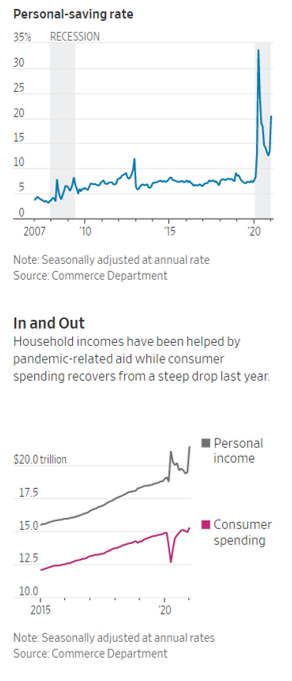
- 02/24/2021 – Joe Biden outlined a more than $2 trillion infrastructure plan called Build Back Better. He said it would be the “largest mobilization of public investment since World War II.” Among other proposals in the plan, Biden would devote about $400 billion to expanding clean vehicle technology, steel production and other building materials. He is also earmarking $300 billion for investments in 5G and artificial intelligence.” As for stock ideas to play this hoped-for super cycle, Morgan Stanley highlights five names poised to benefit: Cemex, Vulcan Materials, Martin Marietta, Summit Materials, and CRH.
5 stocks to buy for the 1950s-style infrastructure supercycle: Morgan Stanley
Morgan Stanley strategists are coming out very bullish on the building materials sector should a long overdue infrastructure bill get passed under President Joe Biden.
“U.S. infrastructure investment has run $1.25 trillion below trend over the past decade. An infrastructure deal could set the stage for a super cycle, especially in cement, with beneficiaries re-rating,” said a 15-person team of Morgan Stanley strategists in a new report titled “Paving the Way for U.S. Infrastructure Super Cycle.” “An infrastructure package could catapult building materials into a super cycle similar to the 1950s. We are 10 years into the current construction cycle, exiting a recession, and potentially facing a government-underwritten cycle of another 10 years.”
The group estimates the U.S. infrastructure needs $3 trillion in repairs. As for stock ideas to play this hoped-for super cycle, Morgan Stanley highlights five names poised to benefit: Cemex, Vulcan Materials, Martin Marietta, Summit Materials, and CRH.
“We decompose the $3 trillion into $398 billion for concrete bridges, $796 billion on concrete roads, steel bridges at $300 billion, and $1.6 trillion to take asphalt roads from poor to good condition. Without changing assumptions on housing or commercial construction, we show that the uplift from infrastructure would be enough to produce another super cycle,” contends the Morgan Stanley team.
The super cycle call on building materials makes sense.
Then presidential candidate Joe Biden outlined a more than $2 trillion infrastructure plan called Build Back Better. He said it would be the “largest mobilization of public investment since World War II.” Among other proposals in the plan, Biden would devote about $400 billion to expanding clean vehicle technology, steel production and other building materials. He is also earmarking $300 billion for investments in 5G and artificial intelligence.”
Now that Biden is president he is expected to make a push for the Build Back Better plan once another round of COVID-19 relief gets passed.
To be sure, the time for a big infrastructure plan is long overdue and desperately needed.
According to new research from the American Society of Civil Engineers, the U.S. economy stands to lose $10.3 trillion in GDP by 2039 if an infrastructure bill isn’t passed. A total of $9 trillion in disposable income among households will be lost over the next 20 years, the research shows. The current state of America’s infrastructure — including gaping potholes on roads, outmanned electrical grids, and suboptimal public transport — is costing the average household in the country $3,300 a year.
U.S. Steel CEO David Burritt recently told Yahoo Finance Live he is looking for an economic super cycle post-pandemic that should power demand for steel.
“I have to say I have gone from — even back in the second quarter of last year — cautiously optimistic, dare I say bullish and now I am sensing there is a super cycle here with lots of cash and liquidity from the Fed. [Federal Reserve Chairman Jerome] Powell did an incredible job last year just amazing. Then we have the relief bill going into place. Even money in that relief bill hasn’t been spent, another $1.9 trillion,” Burritt said.
- 02/23/2021 – Michael Burry recommended website to study macro
https://data.sca.isr.umich.edu/charts.php
- 02/23/2021 – more jobs, more economy growth
Blue-collar jobs booming amid COVID pandemic: Workforce analyst
Job postings are significantly up due to demand in consumer goods, Joanie Bily said
trong demand in manufacturing, logistics as well as trade and transportation have seen the number of job postings for skilled labor increase to 6.6 million in December 2020 compared to 6.5 million in December 2019.
“There is certainly a boom and a really strong demand for blue-collar workers right now,” Bily said.
“The job postings are significantly up in the supply chain industry,” she added. “There’s just a need for the warehouse workers and logistics and we can see that in the demand for consumer goods.”
- 02/23/2021 – Does Powell ignore the warning of inflation and elevated assets?
Jerome Powell Sees Easy-Money Policies Staying in Place – WSJ
Fed likely to hold interest rates near zero and continue asset purchases for some time, chairman says
Federal Reserve Chairman Jerome Powell reaffirmed the central bank’s commitment to maintaining easy-money policies until the economy has recovered further from the effects of the coronavirus pandemic.
“The economy is a long way from our employment and inflation goals,” Mr. Powell said in testimony to the Senate Banking Committee, a statement he has repeated in recent weeks. The Fed will therefore continue to support the economy with near-zero interest rates and large-scale asset purchases until “substantial further progress has been made,” a standard that Mr. Powell said “is likely to take some time” to achieve.
Inflation also remains below the Fed’s 2% goal, a source of long-running worry among policy makers.
Noting that asset bubbles triggered recessions in 2001 and 2007-09, Sen. Pat Toomey (R., Pa.), the top Republican on the panel, asked Mr. Powell if he sees a link between elevated asset prices and the Fed’s easy-money policies.
“There’s certainly a link,” Mr. Powell said. “I would say, though, that if you look at what markets are looking at, it’s a reopening economy with vaccination, it’s fiscal stimulus, it’s highly accommodative monetary policy, it’s savings accumulated on people’s balance sheets, it’s expectations of much higher corporate profits…So there are many factors that are contributing.”
Powell says inflation is still ‘soft’ and the Fed is committed to current policy
- Fed Chairman Jerome Powell characterized inflation as “soft” for the most part and said the employment picture still needs help.
- The pandemic has “left a significant imprint on inflation” and it price pressures are not a threat now, he told the Senate Banking Committee.
Despite a sharp rise this year in bond yields that has accompanied heightened concern over inflation, Powell said price pressures remain mostly muted and the economic outlook is still “highly uncertain.”
“The economy is a long way from our employment and inflation goals, and it is likely to take some time for substantial further progress to be achieved,” the Fed chief said in prepared remarks for the Senate Banking Committee.
He added that the Fed is “committed to using our full range of tools to support the economy and to help ensure that the recovery from this difficult period will be as robust as possible.”
However, Powell’s statement did not mention the market’s most pressing concern: the jump in 2021 of longer-duration government bond yields to levels not seen since before the Covid-19 pandemic. The 30-year bond, for instance, is up more than half a percentage point and the benchmark 10-year yield has risen 44 basis points.
Powell noted that the pandemic “has also left a significant imprint on inflation” and on balance it is not a threat to the economy.
“Following large declines in the spring, consumer prices partially rebounded over the rest of last year. However, for some of the sectors that have been most adversely affected by the pandemic, prices remain particularly soft,” he said. “Overall, on a 12-month basis, inflation remains below our 2% longer-run objective.”
The Fed last year revised its approach to inflation. In the past, it would levy preventive rate hikes when it saw unemployment drop, thinking that a stronger job market would push up prices.
Now, it has adopted an approach in which it will allow inflation to average above 2% for a period of time before moving to tighten policy.
“This change means that we will not tighten monetary policy solely in response to a strong labor market,” Powell said.
- 02/22/2021 – lumber price increases significantly
Record-High Lumber Prices Add $24K to the Price of a New Home
Lumber prices have skyrocketed more than 180% since last spring, and this price spike has caused the price of an average new single-family home to increase by $24,386 since April 17, 2020, according to NAHB standard estimates of lumber used to build the average home. Similarly, the market value of the average new multifamily home has increased by $8,998 over the same period due to the surge in lumber prices.
The latest Random Lengths prices as of mid-February show the price of framing lumber topped $975 per thousand board feet — a 180% increase since last April when the price was roughly $350 per thousand board fee.
- 02/22/2021 –
The Money Boom Is Already Here – WSJ
Since February 2020, the M2 supply has increased 26%—the largest one-year jump since 1943
- 02/22/2021 – When demand improves, the bullwhip effect ripples all along supply chains, cause inflation
Consumer Demand Snaps Back. Factories Can’t Keep Up. – WSJ
Snarled supply chains, labor shortage thwart full reopening; ‘everyone was caught flat-footed’
When demand improves, even modestly, suppliers respond with an outsize increase in production to restock empty warehouses and assembly plants. The so-called bullwhip effect ripples all along supply chains, generating unusually large orders for suppliers that are far from end customers.
This time, the bullwhip effect is even more pronounced because demand for consumer products has been extraordinarily high. At the same time, companies are placing supersize orders to compensate for the extra time it takes to procure supplies from factories and freight operators constrained by global efforts to contain the coronavirus. That’s accenturing the strain on supply chains.
“Customers get concerned about availability,” he said. “They don’t want to be in a situation where they miss a delivery because they’re short on inventory.”
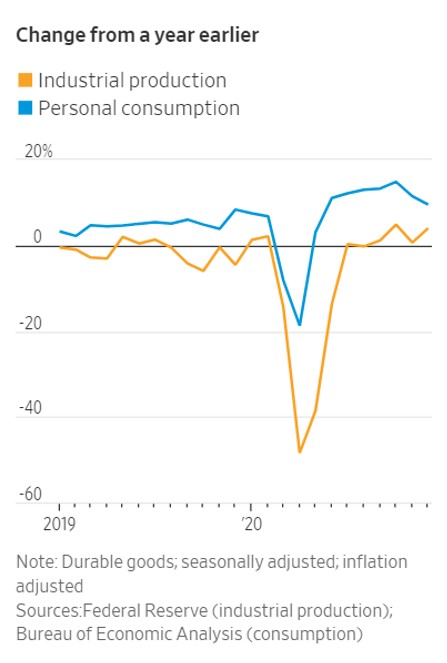
- 02/22/2021 -If the economy begins a fresh expansion, these dynamics favor cyclical and more economically-sensitive stocks. Financials, energy and industrial sectors would benefit the most. Analysts expect stocks in all of these sectors to see continued earnings momentum through 2022. But industrials and energy stocks trade at substantial valuation premiums to the S&P 500, according to FactSet data. Smaller capitalization value stocks aren’t trading at those exorbitant valuations and might be a better way to play the inflation trade.
If Inflation Is Coming, These Stocks Will Benefit the Most
If the economy begins a fresh expansion, these dynamics favor cyclical and more economically-sensitive stocks. Financials, energy and industrial sectors would benefit the most. For banks, loans are more profitable when long-term rates are higher. Demand for oil and other energy sources increases during expansionary times because manufacturers and consumers consumer more during these times. Industrials typically increase production to supply projects tied to business and consumer spending during times of expansion.
According to data from Evercore strategists, the financial sector sees the highest degree of outperformance against the S&P 500 when long-term yields rise. The energy sector is the second-best performer and industrials are the third-best. The sectors least correlated with higher interest rates are defensive ones, or those which have revenues and earnings that are less influenced by economic demand. Utilities and consumer staples, for example, don’t perform as well during inflationary times.
Indeed, the SPDR S&P Bank ETF (ticker: KBE) is up 71% since Sept. 23, trouncing the S&P 500’s 21% gain. Mid-September marks the beginning of a fresh rally in riskier assets like stocks and move higher in inflation expectation. The Energy Select Sector SPDR ETF (XLE) is up 53% since then, with the Industrial Select Sector SPDR ETF (XLI) exhibiting a move in-line with the broader index. Four of the top 10 holdings in the industrials fund— Honeywell (HON), Raytheon Technologies (RTX), Lockheed Martin (LMT) and 3M (MMM)—have heavy exposure to the rather defensive areas of aerospace and defense and medical products, which may weigh on the fund’s performance. But the highly cyclical industrial stock Boeing (BA), for example, has beaten the S&P 500 by nearly twice as much since mid-September.
Analysts expect stocks in all of these sectors to see continued earnings momentum through 2022. But industrials and energy stocks trade at substantial valuation premiums to the S&P 500, according to FactSet data. Smaller capitalization value stocks aren’t trading at those exorbitant valuations and might be a better way to play the inflation trade.
- 02/22/2021 – watch out the stimulus plan on Capitol Hill, higher and higher bond yield benefits bank stocks, We also will get releases on new home sales, the leading indicators, durable goods orders, and the revision to fourth-quarter GDP. And starting tomorrow, investors will be paying close attention to Federal Reserve Chairman Jerome Powell’s prepared remarks before Congress. rotation out of the high-growth stocks, such as technology and into those companies that may be the immediate beneficiaries of any return to normality. The value names in the cyclical sectors (i.e., industrial and materials) are starting to garner some interest on Wall Street
Stock Market Today: February 22, 2021
So what are the major events that investors are zeroing in on in recent days? At the forefront is the ongoing debate over another major stimulus plan on Capitol Hill; the major equity averages cheered comments from Treasury Secretary Janet Yellen last week calling for more coronavirus-driven stimulus. Not surprisingly, the small-cap Russell 2000 rallied sharp on Friday (up more than 2%) when the other major averages saw big swings, but ultimately ended the week’s final session relatively unchanged. Small-sized businesses would likely be a short-term beneficiary of more stimulus. The calls for such stimulus, along with a supportive fourth-quarter earnings season in which the large majority of S&P 500 companies exceeded expectations, and encouraging data of late on the pandemic as more Americans get inoculated with vaccines, are being pit against worries about rising bond yields (historically not a good backdrop for equities) and mixed economic data in recent months.
The rising fixed-income yields have taken a bite out of some of the high-growth stocks, most notably in the technology space. Against this backdrop, and with valuations indeed looking high, we would urge subscribers to give more attention to the value names with top-notch balance sheets. Many of these blue-chip names are among the stocks ranked 1 (Highest) and 2 (Above Average) for Safety by Value Line. These issues have historically outperformed the broader market during turbulent times and with volatility picking up of late we may be entering a stretch where the daily movements among the major equity indexes will test the mettle of some investors, particularly those of a conservative bent. The value stocks tend to outperform the growth names when concerns about inflation surface. We would also look at some of the sectors that will benefit from the Biden presidency. And if bond yields continue to move higher (the rate on the 10-year Treasury note—above 1.30% this morning—recently hit a 12-month high), the large-cap financial names may be of greater interest, as higher yields enhance the earning power of the lending institutions, particularly the banks.
Looking ahead to the week at hand, the main interest of Wall Street will likely be the aforementioned stimulus package debate on Capitol Hill. And on the heels of last week’s strong report on retail sales, a number of the retailers will be in focus, as they begin reporting January year-ending results this week. There will be important data from the business beat, including some reports (i.e., consumer confidence and personal income and spending) that will also push investors’ eyes toward the consumer discretionary sector. We also will get releases on new home sales, the leading indicators, durable goods orders, and the revision to fourth-quarter GDP. And starting tomorrow, investors will be paying close attention to Federal Reserve Chairman Jerome Powell’s prepared remarks before Congress. Given the concerns about the coronavirus’ impact on the labor market and emerging inflationary pressures, his commentary will be closely scrutinized and may potentially influence trading over the middle sessions of this busy week for Wall Street.
Before the bell, the equity futures point to a lower start for the U.S. stock market. So far overseas, it has mostly been a sea of red ink. The main indexes in Asia finished with losses overnight, while the major European bourses are in negative territory as trading moves into the second half of the session on the Continent. As noted above, what we are likely to see at the commencement of trading stateside is some continued rotation out of the high-growth stocks, such as technology (the NASDAQ futures point to some selling in the big-tech names), and into those companies that may be the immediate beneficiaries of any return to normality. The value names in the cyclical sectors (i.e., industrial and materials) are starting to garner some interest on Wall Street.
- 02/21/2021 – declined inv/sales ratio, business cycle, better credit conditions are good for equities
A Strong Economy And Easier Lending Standards Are Fueling The Bull Market
- Business shows its optimism with its investments.
- Credit conditions are easing.
- The business cycle is on a strong upswing – good news for equities.
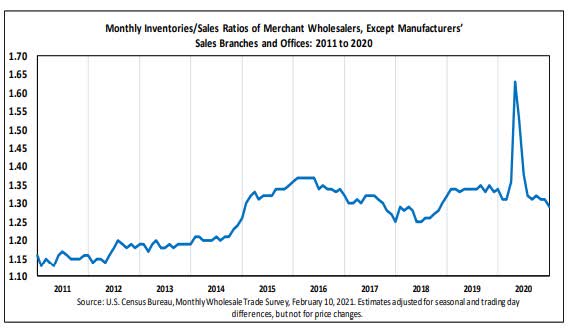
The latest inventory to sales ratio released by the Census shows a sharp decline in the ratio. This is another bullish trend for the economy. It means sales are rising much more rapidly than inventories. Business will be forced to produce more goods to replenish inventories.
The outcome is increased production, purchases of more raw materials (commodity prices are likely to keep rising), more hiring (employment in the crucial manufacturing sector will keep rising), and more borrowing to finance the manufacturing activity (placing upward pressure on interest rates).
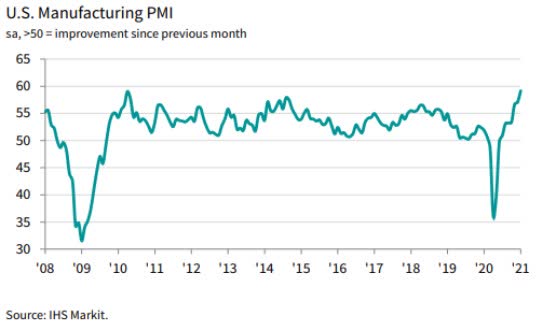
The above indicator confirms this is exactly what is happening. The US survey of manufacturing (Markit) shows the percentage of purchasing managers responding positively soared to 59.2. This measure is one of the strongest among the developed economies. Taiwan’s index was 60.2. the Netherlands reported 58.8. China’s index was 51.5. The global index finished at 53.5.
All this could not be possible, of course, without the help of the banking system.
The latest survey of the Fed about measures of supply and demand for commercial and industrial loans shows lending officers easing aggressively lending standards (see above chart). This is an important trend because it confirms credit conditions are improving. This effort to ease credit will further support an already strengthening economy.
Another reliable feature of this index is every major bull market started when the net percentage of lending officers easing credit declined from above 50% – as in the past few months. On the other hand, a major market pause took place following an increase of the net percentage of lending officers tightening lending standards decisively above 0%.
- 02/21/2021 – inflation angst
- inflation is bad for bond, good for some equities given the companies to wring profits from higher prices. Goldman Sachs Group Inc. recommends companies better equipped to derive earnings from sales, such as automaker Ford Motor Co. and media firm Discovery Inc. To Societe Generale SA, supply and demand imbalances suggest mining shares and fertilizer producers offer better hedges should pressures build.
- Energy shares have been persistent winners during times of high inflation over the past five decades.
- Societe Generale’s strategists led by Andrew Lapthorne have built a basket of stocks based on their sensitivity to metrics like fluctuations in copper and food prices. Basic materials, technology and energy shares currently make up two thirds of the portfolio.
Inflation Angst Is About to Rewrite the Stock Market Playbook
(Bloomberg) — For bond investors, inflation is pretty much all bad news, eating into the value of future returns. For equity traders, the tidings can be less categorically awful, given the ability of certain companies to wring profits from higher prices.
While there will be plenty of stock-market casualties should price pressures perk up, history suggests the landscape isn’t devoid of opportunity. Energy shares have been persistent winners during times of high inflation over the past five decades, a study from Ned Davis Research shows.
Goldman Sachs Group Inc. recommends companies better equipped to derive earnings from sales, such as automaker Ford Motor Co. and media firm Discovery Inc. To Societe Generale SA, supply and demand imbalances suggest mining shares and fertilizer producers offer better hedges should pressures build.
No matter how sanguine Federal Reserve Chair Jerome Powell is about the topic right now, inflation will one day matter again for stocks. Just in the last few weeks, hawks have observed worrying signs in everything from a global shortage of computer chips to the biggest jump in U.S. producer prices on record.
With the economic outlook brightening, Covid-19 cases falling and more fiscal stimulus on the horizon, nervousness about inflation is percolating. That means pricing power is set to become “an intriguing alpha generator” due to the wide variance in how companies cope with it, according to Tobias Levkovich, Citigroup Inc.’s chief U.S. equity strategist.
“Lead indicators suggest that an inflation scare may be in the making,” Levkovich wrote. “Companies with price flexibility should come out as winners.”
Energy stocks have the best track-record during periods of rising consumer prices, according to Ned Davis. In seven out of nine cases of high inflation since 1972, the industry outperformed the S&P 500 by a median of 14 percentage points, the study showed.
When ranked by investment style, cyclical value stocks — companies whose sales are more sensitive to economic swings and usually trade at relatively cheap valuations — tend to do better when inflation runs high, Ned Davis noted.
Crude oil has surged this year, bolstered by confidence in a global economic recovery. Those bets have been reflected in the stock market, with energy producers including Exxon Mobil Corp. and Marathon Oil Corp. soaring. The industry has led gains in the S&P 500 in 2021, climbing five times more than the equity benchmark.
While inflation’s ramifications for the broader market are not straightforward, a look under the surface shows investors are preparing for the outcome by favoring companies with high operating leverage, or the ability to extract profits from revenue.
While both sales and input costs tend to increase when inflation rises, companies with strong leverage potentially offer a safer trade. The reason is: the effect of growing revenue would outweigh the production costs.
Since the start of February, a basket of stocks with the highest operating leverage that strips out industry bias has beaten the cohort of weakest ones by 1.7 percentage points, data compiled by Goldman Sachs and Bloomberg show. The gauge is poised for a fourth straight month of outperformance, the longest streak since the taper tantrum year of 2013.
Higher input costs such as commodities pose little threat to overall earnings for S&P 500 companies partly because some industries gain as material prices climb and others hedge exposure, according to Goldman Sachs strategists including David Kostin.
Labor costs, on the other hand, are a bigger headwind, with an increase of 100 basis points in wage growth likely amounting to a 1% reduction in company profits, their estimates show. Accordingly, they advise investors to favor firms whose labor costs make up a smaller share of revenue, such as Under Armour Inc. and Biogen Inc.
“Many investors believe the spending boost will lead to higher inflation and interest rates, which would reduce the value of equity duration and increase the importance of near-term growth,” Kostin wrote in a note earlier this month. “Historically, inflation has boosted nominal S&P 500 revenues, but weighed on profit margins as companies struggled to lift prices at the same pace as rising input costs.”
Societe Generale’s strategists led by Andrew Lapthorne have built a basket of stocks based on their sensitivity to metrics like fluctuations in copper and food prices. Basic materials, technology and energy shares currently make up two thirds of the portfolio.
While the group has proved its worth by rising with inflation expectations in recent months, one drawback is its poor performance during times of disinflation — something that has gripped the market for much of the past decade, they noted. To offset that deficiency, the Societe Generale strategists designed a trade dubbed “call replication” that limits the downside risk while maximizing the upside.
“When we speak to investors, they want the upside from value rallies and would like to hedge inflation risk, but most find the volatility incompatible with their risk tolerance,” Lapthorne wrote in a note Thursday. “Call replication strikes the right balance.”
- 02/20/2021 – the entire world economy is in the grips of reflation. However, the thing to worry about is the direction of fiscal policy, which will almost certainly bring us higher taxes, increased regulatory burdens, and more expensive energy. To be fair, higher inflation combined with today’s very low interest rates will lighten Treasury’s debt burden significantly over time. Potential disaster is not imminent, but it is certainly on the horizon. No one with foresight is sleeping easy these days.
It’s all about reflation now
Just about the entire world economy is in the grips of reflation. What’s reflation? My definition of reflation is when economic activity and prices are all moving higher. Economic growth is returning to almost every country in the world, and almost all commodity prices are rising. Reported inflation is still “tame,” but inflation expectations are rising. The Fed has determined that they want inflation to be higher, and they are getting their wish.
The Fed’s current monetary policy stance, in short, is not sustainable. Sooner or later they will be yanking the punchbowl. Many observers realize this, but no one knows how long the current situation can last. The Fed has convinced the bond market that short-term interest rates are going to be pegged at extraordinarily low levels for the next two years. I sincerely doubt the Fed will be able to stick to this promise.
The thing to worry about is the direction of fiscal policy, which will almost certainly bring us higher taxes, increased regulatory burdens, and more expensive energy.
To be fair, higher inflation combined with today’s very low interest rates will lighten Treasury’s debt burden significantly over time.
Potential disaster is not imminent, but it is certainly on the horizon. No one with foresight is sleeping easy these days.
- 02/19/2021 – Earnings, Key economic reports and Biden’s $1.9T bill will come next week. Expect good data and outlook. Try to get in for short and long term LEAPs?
Stronger economic data could power stocks that thrive in a rebound in the week ahead
- Stocks that do well when the economy improves could continue to move higher at the expense of tech and growth in the week ahead, if market focus remains on better data and stimulus.
- That so-called reflation trade sent the 10-year Treasury yield to its highest level in a year.
- Federal Reserve Chairman Jerome Powell speaks Tuesday and Wednesday before the Senate Finance Committee and House Financial Services Committee.
Key data during the week
Earnings continue to be important. There are more than 60 companies reporting, including Home Depot, Macy’s and TJX.
Key economic reports dropping next week include durable goods on Thursday, along with personal income and spending data on Friday, The Friday report includes the personal consumption expenditure price index, which the Fed monitors. The market is on the lookout for signs of rising inflation.
“I think the boom is going to start sooner than most people think,” said Ed Keon, chief investment strategist at QMA.
He said the stronger economy is helping drive Treasury yields higher, with the 10-year hitting a one-year high of 1.36% on Friday. Keon said the vaccine rollout is helping the outlook, as is the slowing spread of the virus.
- 02/19/2021 – Another $3T bill for infrastructure, manufacturing revitalization, and green energy is coming? economy and market will get over heated by this.
Will more stimulus follow Democrats’ $1.9 trillion relief bill?
White House Press Secretary Jen Psaki said there are discussions about possible future agenda items
The Washington Post reported this week that discussions have already begun regarding a $3 trillion bill, which would include Biden’s previously detailed plans for infrastructure, manufacturing revitalization, and green energy.
When asked whether a $3 trillion package would follow the $1.9 trillion relief bill, White House Press Secretary Jen Psaki said on Thursday that there are ongoing discussions about possible future agenda items – though no firm decisions have been made.
Three people familiar with the matter told The Post that the $3 trillion figure was being kicked around for the second bill, which would be on top of a potential $1.9 trillion and $4 trillion spent under the former administration. Spending figures, however, are said to be very preliminary.
- 02/18/2021 – Burry recommended book on inflation, I have downloaded this book and need to read through it.
https://recision.files.wordpress.com/2010/12/jens-parsson-dying-of-money-24.pdf
- 02/17/2021 – watch out the increase of bond yield
Stocks finish mixed as bond yields reach pre-coronavirus levels
Oil, gasoline prices jump as Texas remains in deep freeze
The air came out of the stock market as the benchmark 10-year yield approached 1.3%, a level last seen just before the U.S. economy was devastated by lockdowns aimed at slowing the spread of COVID-19. The selloff in the Treasury complex swung the spread between the 2-year and 10-year yield to 116 basis points, its widest point in nearly four years.
Higher yields can signal more expensive borrowing costs which helped drive shares of JPMorgan Chase & Co., Goldman Sachs Group and Bank of America Corp. which all benefitted from the steeper yield curve.
- 02/16/2021 – If the $2~4 Tri infrastructure plan got approved, energy industry might boom
Biden to meet with unions pushing for infrastructure spending
Talks are in advance of a soon-to-be unveiled economic recovery package
President Biden is scheduled to meet in the White House Wednesday with senior labor union leaders, who are hoping to win commitments for a massive federal investment in infrastructure as well as efforts to create jobs in clean-tech and alternative energy, according to people familiar with the matter.
Sean McGarvey, president of North America’s Building Trades Unions, will be meeting with the president and Vice President Kamala Harris in the Oval Office, and may be joined by AFL-CIO President Richard Trumka and other labor leaders, according to some of the people.
White House officials have been holding regular meetings with lawmakers and outside groups as the president prepares to unveil an economic recovery package that will focus on improving U.S. infrastructure and creating jobs. Last week, Mr. Biden met with a bipartisan group of senators, as well as mayors and governors.
When asked about the meeting, White House spokesman Vedant Patel said via email that the administration “will evaluate infrastructure proposals based on our energy needs, their ability to achieve economy wide net zero emissions by 2050, and their ability to create good paying union jobs.”
- 02/16/2021 – this week’s catalyst: 4Q earnings, Wednesday brings us January’s tallies on retail sales, industrial production and the minutes from the last FOMC meeting. This will be followed on Thursday by the latest figures for housing starts, and building permits, and existing home sales on Friday. Next week’s catalyst: Biden’s $1.9 proposal. Development of CV fix – I might need to find entry point this week and next
from valueline: Stock Market Today: February 16, 2021
The major indexes have been edging their way higher in February, largely driven by hopes of positive developments on the coronavirus front and the likelihood that the government will pump additional liquidity into the system. Regarding the former, the rollout of vaccines in the U.S. continues to ramp up, and it appears that the majority of U.S. citizens should have access to vaccination by the end of summer. As to the prospects for a new stimulus package, current estimates among economists are hovering not far from the neighborhood of President Biden’s $1.9 proposal. For individuals, key components of the proposed legislation include a new round of relief checks for those in lower income brackets, the extension of unemployment benefits, and additional assistance to households with children. The hope is that government spending will be enough to jump start the economy as things begin to reopen.
As we look to today’s session, stocks began the day in mixed fashion. Markets in Asia were up solidly, but the European bourses are hovering around breakeven. On our shores, the futures are indicating a positive open with the major indexes poised to move further into record territory as we begin the holiday-shortened trading week.
Meanwhile, fourth-quarter earnings season remains in full swing and, so far, results have largely come in better than expected. However, these reports from Corporate America are not likely to be a priority among investors, as attention remains fixed on the pandemic.
In the meantime, on the economic front, Wednesday brings us January’s tallies on retail sales, industrial production and the minutes from the last FOMC meeting. This will be followed on Thursday by the latest figures for housing starts, and building permits, and existing home sales on Friday.
- 02/15/2021 – Near term should be pleasantly robust, as the economy emerges from its Covid travails and a return of confidence boosts consumer confidence and business investment. However, ee’ve been living in a sub-par recovery since I first anticipated it back in early 2009, thanks to too much regulation, high taxes, and too much government spending. Those same forces will act as headwinds for the economy in the years to come, with Biden promising a virtual replay of all of Obama’s anti-growth policies—and possibly even more. Slow growth has left the economy substantially weaker and smaller (by about $4.5 trillion per year, as shown by the gap between the blue and green lines) than it might have been had the prior 3.1% growth trend persisted. As government spending consumes a greater portion of economic output, economic growth becomes weaker
Despite a catastrophic decline in GDP in the first half of last year, the US economy managed to stage an almost complete rebound in the second half. By the end of 2020 the economy was only 2.5% smaller than its year-end 2019 level. Most observers expect at least a few more strong quarters of growth, which will almost certainly allow the economy to break new high ground within the next several months.
Chart #1 uses the magic of a logarithmic y-axis to show how the US economy followed a 3.1% annualized growth track for 50 years. (With a logarithmic y-axis, a line with a constant slope represents a constant rate of growth.) Then, beginning in 2009, it managed to grow only 2.1% per year for the subsequent decade. (See this post for more details as to why.) We’ve been living in a sub-par recovery since I first anticipated it back in early 2009, thanks to too much regulation, high taxes, and too much government spending. Those same forces will act as headwinds for the economy in the years to come, with Biden promising a virtual replay of all of Obama’s anti-growth policies—and possibly even more. Slow growth has left the economy substantially weaker and smaller (by about $4.5 trillion per year, as shown by the gap between the blue and green lines) than it might have been had the prior 3.1% growth trend persisted.
Unfortunately, economic growth is not about to set any long-term records. For 50 years, from 1966 through 2007, the US economy grew at an average annualized rate of about 3.1%—a great and dynamic expansion which saw the economy almost quintuple in size. The came the Great Recession of 2008-9. Not only did the economy fail to recover to that long-term 3.1% trend in subsequent years—for the first time ever, following a recession—it went on to post only slightly more than 2.1% annual growth in the decade from 2009 through early 2019. It was the weakest economic expansion on record, and it looks set to continue for the foreseeable future, I’m sorry to say.

Near term, though, growth should be pleasantly robust, as the economy emerges from its Covid travails and a return of confidence boosts consumer confidence and business investment (see Chart #4, which shows capital goods orders, which are a good proxy for business investment). There’s a lot of slack in the economy that will be put back to work as the Covid problem slowly recedes; already, daily new Covid cases are declining nearly everywhere and vaccinations are proceeding at an impressive pace. At the same time, Covid-related restrictions have forced the economy to do more with fewer resources, thus providing a one-time boost to productivity, which surged at a 7.5% annualized pace in the second and third quarters of last year and likely closed out the year on an unusually strong note.
A final note: inflation expectations embedded in TIPS and Treasury prices are now approaching 2.33%, as Chart #6 shows. This cannot go on much longer, I fear. Sooner or later Treasury yields are going to have to start rising. But in the meantime, it pays to borrow, since interest rates are so low relative to inflation, and it pays to buy, since expected returns on non-cash assets are much higher. It’s not unreasonable to think we are in the early stages of an inflating “asset bubble.”
All of these considerations leave me nervously optimistic about the long-term outlook for equities. I don’t think the Fed’s desire to boost inflation is consistent with a long-term healthy economic outlook, because higher inflation will eventually undermine confidence and the economy. Unprecedented monetary expansion in recent years has not yet resulted in any significant increase in inflation, but only because the demand for cash has been extremely strong. Sooner or later the Fed will get its way and money demand will fall (market sages are fond of saying you should never bet against the Fed’s ability to get what it wants, and I think they are right). But just how long the Fed can undermine the world’s demand for cash and avoid an unhealthy increase in inflation is really the only issue at this point. If the Fed doesn’t thread this needle just right, inflation expectations could become “unmoored,” and that eventually would lead to a significant tightening of monetary policy which in turn would most likely result in yet another recession somewhere down the road.
Meanwhile, “borrow and buy” should continue to be your mantra, even if it makes you nervous.
The (destructive) power of transfer payments

As government spending consumes a greater portion of economic output, economic growth becomes weaker.
- 02/12/2021 – watch out the interest rate increase
The 30-Year Treasury Just Hit 2%. When Will Yields Start Hurting the Stock Market?
After a long grind higher in long-term Treasury yields, the 30-year just climbed above 2% for the first time since Covid-19 hit. That has investors asking when the broader trend of rising bond yields will hurt the stock market.
The central concern is that once Treasury yields climb high enough investors will want to buy safe bonds instead of stocks or high-yield debt. But it isn’t clear when that will occur, and the 30-year bond carries extra risk of losses as yields keep rising. When it comes to the 10-year note, a more popular benchmark, Wall Street consensus is hard to find: Strategists’ forecasts say 10-year Treasury yields may need to rise only to 1.75%, or as high as 5%, to make them more attractive than those riskier alternatives.
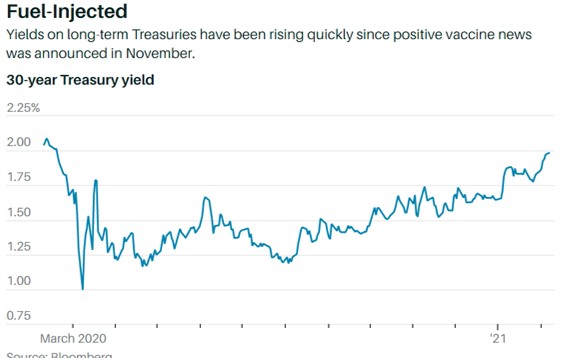
- 02/10/2021 – The Odds of a Hard Economic Landing in the U.S. by 2023 Are Growing. inflation and interest rates are heading higher as better economic growth in the last half of 2021 is delivered by the unprecedented stimulus. Unfortunately the stimulus is in the form of mostly transfer payments and not in expansion of productivity or capacity. As I see it, the economic boom will be a sugar-based high and there is an almost inevitable bust cycle emerging by or in 2023 when the heady fiscal stimulus ends. Today’s record stock prices belie a likely hard economic landing that may lie ahead
from Tilson’s Daily: I think my friend Doug Kass of Seabreeze Partners is likely right… Here’s his recent missive:
The Odds of a Hard Economic Landing in the U.S. by 2023 Are Growing
- A boom cycle may be on tap for the second half of 2021 as unprecedented stimulus (25% of GDP!!!) leads to higher interest rates, inflation, and better growth
- There were mild recessions following the Korean and Vietnam wars – but the scale of the military expenditures during those times were only between 2% to 4% of GDP
- But that boom will likely be short lived as the drying up of fiscal stimulus will likely lead to a bust within two years
- Even excessive monetary expansion may not save the U.S. economy as it is taking more and more liquidity to produce a unit of [GDP] production
- Bookmark this post!
Though this post is short and to the point, the broader consequences for the economy and for the stock market are great.
The anticipated cumulative injection of fiscal stimulus (including the proposed $1.9 trillion Biden stimulus package and the previous $2.2 trillion and $0.9 trillion packages) will total $5 trillion over the last 12 months. This represents almost 25% of the anticipated GDP of $21 trillion.
As former Alliance Bernstein economist Joe Carson mentioned over the weekend – with the exception of World War II there has been nothing like this in history. Stimulus during World War I, in the Great Depression, and in the Great Decession of 2008-2009 didn’t come close to the policy initiatives in reaction to COVID-19 – even though those periods had deeply depressed private sector activity. Today we are experiencing a rebounding manufacturing economy led by housing activity and higher home prices.
This chart demonstrates how large the recent stimulus has been in an historic context:
At the same time, the Federal Reserve’s policy remains extremely aggressive and will be “as far as they eyes can see” – leading to very hot real estate markets around the country, particularly in wealthy communities.
Bottom Line
To me, there is only one inescapable economic conclusion: inflation and interest rates are heading higher as better economic growth in the last half of 2021 is delivered by the unprecedented stimulus.
Unfortunately the stimulus is in the form of mostly transfer payments and not in expansion of productivity or capacity.
As I see it, the economic boom will be a sugar-based high and there is an almost inevitable bust cycle emerging by or in 2023 when the heady fiscal stimulus ends.
Today’s record stock prices belie a likely hard economic landing that may lie ahead.
- 02/09/2021 – Be aware of Burry’s warning on market top: Burry hinted in yet another tweet that he expects a market crash in the coming months
‘Big Short’ investor Michael Burry says Tesla’s $1.5 billion bet on Bitcoin was a distraction – and Dogecoin’s record price signals a massive bubble
- “The Big Short” investor Michael Burry suggested Tesla bought Bitcoin to distract from regulatory issues in China.
- Burry also pointed to Dogecoin’s record price as evidence of a huge market bubble.
- The Scion Asset Management boss revealed he was short Tesla in December.
“We are in a blow-off top in all things,” Burry continued, referring to a chart pattern that shows a steep increase in an asset’s price and trading volume, followed by a rapid price decline.
“Markets have now bubbled over in a dangerous way,” he said in an earlier tweet.
Burry hinted in yet another tweet that he expects a market crash in the coming months. He linked to “When The Levee Breaks,” a Led Zeppelin song, and said, “This time we’ll play it at the beginning, not at the end.”
- 02/08/2021 – increase of bond yield indicates inflation is coming
Bonds Are Sending a Message: Inflation Is Coming
The yield curve—the graph of Treasuries from short- to long-term maturities—is the most sharply upwardly sloped in years. That’s a result of longer-term yields climbing, with the benchmark 10-year note ending the week at 1.17%, near the high end of its recent trading range, and the 30-year bond at 1.98%, nearing 2% for the first time in about a year.
This is a classic indication that the bond market is anticipating stronger economic growth and higher inflation. Those expectations got a boost Friday after both houses of Congress voted to begin the process of approving President Joe Biden’s $1.9 trillion fiscal relief plan without votes from congressional Republicans.
- 02/04/2021 – steepest yield curve is great for bank stocks
The Yield Curve Is the Steepest It Has Been in Years. Here’s What That Means for Investors.
Long-term Treasury yields have been rising much faster than shorter-term yields, a sign that investors are betting on further acceleration in the U.S.’s economic recovery.
The steepness (or flatness) of the yield curve—the change in yields across different Treasury maturities—is seen as an indicator of economic growth. When the curve “inverts,” or long-term yields fall below short term yields, it is seen as a recession warning. Now the curve is getting steeper, a sign that investors expect stronger U.S. growth and inflation in coming decades.
Steep Curve Ahead
Long-term Treasury prices have declined since August, creating a steeper yield curve.
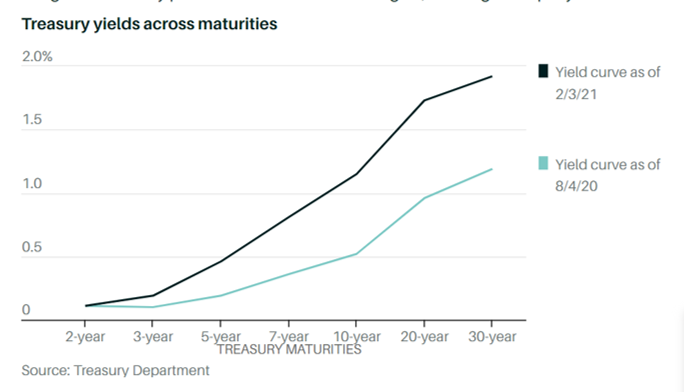
Since August, 30-year Treasury yields have climbed 73 basis points, or hundredths of a percentage point, to 1.92%. The 20-year yield has climbed 77 basis points to 0.96%, and the 10-year yield has climbed 63 basis points to 1.15%. Those jumps look even more pronounced compared with yields of shorter-term notes, which haven’t moved as much.
One of the most-watched measures of the yield curve, the gap between 2- and 10-year yields, is the widest it has been since 2017. And notably, the gap between a slightly less prominent pair of Treasury maturities, the 5-year note and 30-year bond, has reached its widest since 2015.
First, the steady rise in yields could help preclude a “taper tantrum” like the one that happened in 2013, when long-term Treasuries sold off sharply after then-Fed Chairman Ben Bernanke surprised investors with a discussion of a reduction in the central bank’s bond-buying program that was started amid the financial crisis.
Deutsche Bank strategists predict that the Fed will start discussing reducing the pace of purchases this year, but won’t start winding down until mid-2022. And in a note earlier this week, they pointed out that investors are already less bullish on Treasuries than they were heading into Bernanke’s 2013 comments, making a destabilizing sharp reversal less likely.
Second, bank stocks may continue to post strong performance. Banks’ net interest margins get a boost when the yield curve steepens, as banks generally borrow short term and lend long-term. The SPDR S&P Bank ETF (ticker: KBE) is up nearly 11% this year.
When it comes to the broader stock market, however, the jury is still out. Some strategists have expressed concern about the impact of higher yields on stocks’ valuations. Yet the economic recovery that is driving yields higher should also drive corporate earnings growth; the S&P 500 is up 2.7% this year as yields climb.
Treasury yields climb after better-than-expected jobs data
- Private companies added 174,000 jobs in January, which was well above the 50,000 payrolls estimate from economists surveyed by Dow Jones.
- Initial jobless claims from the last week of January were better than expected.
U.S. Treasury yields continued to climb on Thursday morning, as investors watched for progress on an economic relief plan, and also following better-than-expected private jobs data.
The yield on the benchmark 10-year Treasury note rose to 1.139%,, while the yield on the 30-year Treasury bond advanced to 1.935%. Yields move inversely to prices.
- 02/04/2021 – Biden admin aim to get full employment through $1.9 trillion stimulus plan, plus a second economic program as long-term investments such as infrastructure and clean energy. Both approaches might be great for the economy. I should also keep in mind that the road is always bumpy. So I need to learn how to ride on it
The Biden Administration’s Elusive Stimulus Goal: Full Employment
Before the pandemic, low joblessness boosted prosperity without overheating the economy. Getting back there is the top economic aim of the Fed and White House
The Biden administration’s spending proposal sends additional checks to households and directs more funding to a national vaccination program. In the coming weeks, it is planning to ask Congress for a second economic program it will frame as a jobs effort, with even more spending on programs it sees as long-term investments such as infrastructure and clean energy.
The first round of spending, administration officials say, will help tame the virus and keep households and businesses whole until activity resumes and private-sector spending picks up.
The $1.9 trillion proposal, even without the planned second round, would push the jobless rate as low as 3.2% in late 2021 and early 2022, according to a report from Brookings Institution economists Wendy Edelberg and Louise Sheiner.
The Fed has undergone its own shift in thinking about jobs in recent years. Fed officials—including Ms. Yellen when she worked there as chairwoman and in other top jobs—have long thought that as unemployment falls, inflation pressures build. Economists call it a “Phillips curve,” named after the late economist A.W. Phillips, who observed an interplay between jobs and wages in the U.K. in the 1800s and early 1900s.
Yet before the pandemic, the Fed watched the jobless rate fall below 4% with no impact on inflation, which has run about a half percentage point below its 2% target since the target was created in 2012.
Seeing diminished risks to inflation, Fed Chairman Jerome Powell has made it clear he wants to get back to such low levels of unemployment quickly.
- 02/01/2021 – be aware of the potential risks in the market: 3R’s of rates, regulation, redistribution are the historic catalysts that end bull markets & bubbles
Get ready for a 10% stock drop, driven by the 3 ‘Rs,’ warns Bank of America
Bank of America was ringing alarm bells over equities on Friday, as it warned a correction is looming.
“3R’s of rates, regulation, redistribution are the historic catalysts that end bull markets & bubbles…we say all ’21 events, not ’22, and all spell lower/volatile coming quarters/years,” said Michael Hartnett, chief investment strategist at the bank, in the Flow Show note to clients.
He said investors may be facing higher inflation in the second quarter, and while it is possible the Federal Reserve may turn more dovish at its March, April and June meetings, there are headwinds. That shift would coincide with 5% gross domestic product growth, more than 20% profit growth, around 3% inflation, and “visible signs of Wall Street excess speculation,” he said.
- 01/15/2021 – Fed says economy may come back earlier
Fed’s Powell says US economy may return to pre-crisis levels ‘much sooner’ than expected
Powell said he is ‘optimistic’ about outlook for economy
Federal Reserve Chairman Jerome Powell said Thursday the U.S. economy could return to pre-coronavirus pandemic level “fairly soon” thanks to a torrent of monetary and fiscal aid over the past year.
The nearly $4 trillion in direct fiscal stimulus approved by Congress and the Trump administration — including the $2.2 trillion March CARES Act and the $900 billion relief bill passed in December — played a vital role in staving off deeper economic damage, Powell said.
While he stressed that the economy will not fully recover until the pandemic is under control, the central bank head said he was “optimistic” about the outlook over the “next couple of years.”
- 01/17/2021 – interesting predictions on 2021
“Prediction Consensus: What the Experts See Coming in 2021” from Visual Capital

- 01/13/2021 – watch out these three big market risks (from BNY Mellon investment management)
- an unsuccessful vaccine rollout
- rising taxes in 2022
- spiking treasury yields
- fed might start tapering near end of 2021
- 01/11/2021 – Barron’s also warn about the rising of interest rate on stock market. Good to take note on this. rates quickly soared that much, without the gain in earnings that a higher PMI and a stronger economy would ordinarily bring, stock valuations would tumble.
Interest Rates Have Soared. That Could Put a Dent in Stocks Soon
The yield on 10-year Treasury debt rose to 1.1% by Friday from 0.91% to end Monday. With the Democrats winning control of the Senate, the likelihood has increased that Congress will approve spending at least a few hundred billion more dollars to prop up the economy. That means better growth and slightly higher inflation could emerge. Bond yields reflect those expectations.
“The reason they [rates] are spiking is in anticipation of stimulus,” JJ Kinahan, chief market strategist at TD Ameritrade told Barron’s. “Are we headed to an inflationary scenario?”
A gradual move higher in interest rates is generally seen as a sign of optimism, but a sudden spike in yields—or one the market isn’t yet priced to reflect—could become problematic for stocks. Higher interest rates pressure stock valuations because they erode the value of future corporate profits.
Valuations, while stretched according to some, are arguably not at nosebleed levels. At current prices, the S&P 500’s equity-risk premium—the earnings yield the average stock in the index brings in over and above what investors could get from holding safe 10-year Treasury debt—is at 3.27%. The premium often hovers just above 3%, suggesting valuations aren’t out of control.
At the same time, though, it rarely falls below 3%, and when it does, stocks often drop. Edwards says in his report that data suggest bond yields are set to surge. If earnings yields on stocks didn’t rise correspondingly, that would mean a narrower risk premium.
He said that yields on 10-year Treasury debt tend to rise and fall along with moves in the Institute for Supply Management Purchasing Manager Index, or PMI, for manufacturing. And that measure recently hit roughly 60, the highest level since 1995. That should correlate to a 1.2 percentage-point increase in the 10-year yield.
If rates quickly soared that much, without the gain in earnings that a higher PMI and a stronger economy would ordinarily bring, stock valuations would tumble.
- 01/10/2021 – mixed viewpoints of market direction. Watch out the inversion of yield curve (once the economy grows, inflation goes up, yield curve inverses, Fed has to increase long term interest rate to avoid over heat on inflation, market might crash) for opportunity to invest
background knowledge on Inverted Yield Curve, Open market operation, What Is the Relationship Between Inflation and Interest Rates?
Todd thinks: The market is not what I would call “overvalued” at all based on current data, it is not, though, by any means “cheap”. If economic conditions continue to deteriorate, there is room, I think, for a significant leg down.
Davidson: While more useful at market lows, the SP500 Value Investor Index has some utility in gauging excess market sentiment. The past two cycles peaked in 2000 and 2007 at 100% and 65% premiums to the SP500 Value Investor Index. Today, the premium is ~36% which suggests that a hefty rise in the SP500 remains in coming years.
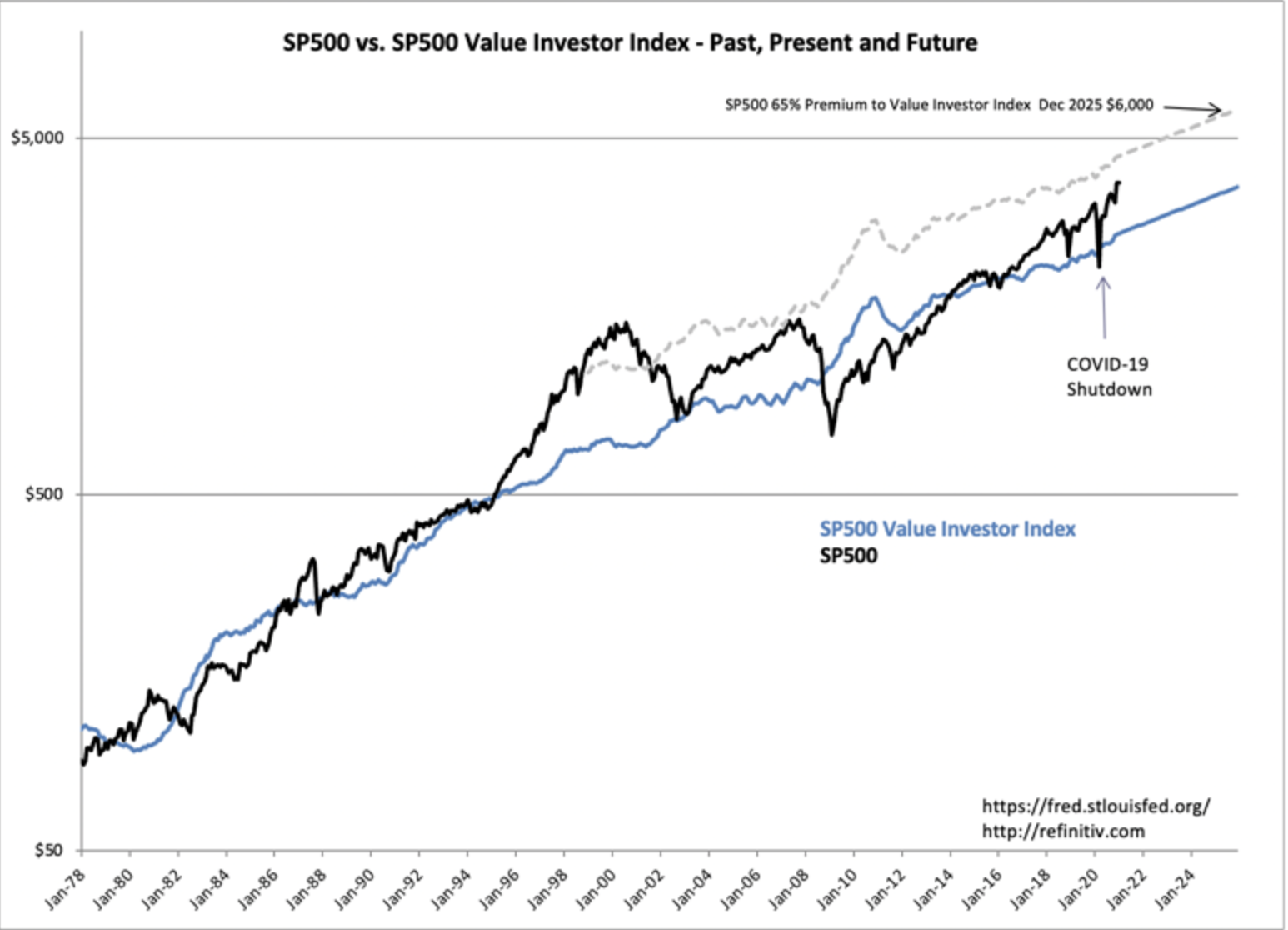
Grantham Warns We Are in the Midst of an Epic Bubble
Veteran value investor Jeremy Grantham (Trades, Portfolio) said is his note published on Jan 5, 2021 that we are in the epic bubble on the scale of “South Sea bubble, 1929, and 2000.” While it is impossible to know when this bubble will burst, we know it will sooner than later. As Grantham wrote in the note,
“These great bubbles are where fortunes are made and lost – and where investors truly prove their mettle. For positioning a portfolio to avoid the worst pain of a major bubble breaking is likely the most difficult part. Every career incentive in the industry and every fault of individual human psychology will work toward sucking investors in.”
What could cause this fever to break? I think the following are some clear risks which we will have to keep our eyes on.
- The economic recovery. If the market perceives that the economic recovery from the pandemic is anything other than V-shaped, this may cause the bubble to burst.
- The sudden appearance of inflation. Given the amount of liquidity pumped into the system following Covid, even if the economy does deliver a V-shaped recovery, inflation may rear its head. This will cause short term rates to rise, and with the Fed holding down long term rates, there is a risk that yield curve might flatten or reverse. This could cause investors to recalibrate as an inverted yield curve may portend a double dip recession in the near future.
- Something happens to the leaders of the stock market bubble, e.g., one of the FAANG stocks is affected by antitrust lawsuits or similar. Given that these stocks are “retail investor” favourites are now such an increasingly larger part of the S&P 500 index, a stumble by one or two them can trigger a run on the index due to margin calls and out of the money call options.
The following chart shows the outperformance of the FAANG stocks compared to the rest of the S&P 500 over the last eight years.

The following chart compares the price of Tesla (NASDAQ:TSLA), a retail investor darling, with General Motors (NYSE:GM) and the S&P 500 since March 23, 2020, which marked the bottom of the bear market. As we can see, Tesla’s stock has gone ballistic.
Another sign of reckless behavior by investors is the sheer number of “call options” being bought.

Theme and comment
The successful development of vaccines in record time regardless of delays and rates of cooperation. The economy has turned sluggish, but not to worry. Stimulus is on the way!
Most investors have experienced a time where skepticism about forward earnings was standard practice. Looking only at past earnings, markets seemed perpetually expensive.
Investors now have a new sense of optimism. They are looking beyond near-term events and peering into the future, perhaps well into the future. It raises a crucial question:
Can corporate earnings grow enough to justify current stock prices?
Barron’s reports, Earnings Season Is About to Begin. Investors Are Already Looking Past it. Read the entire article to see the discussion of data and stocks, helped by “ultrasupportive monetary and fiscal policies.”
In sharp contrast, Carmen Reinhart, chief economist of the World Bank, covers many crucial points in her interview with Leslie P. Norton of Barron’s. And yes, she is the co-author of the influential book warning about debt, This Time Is Different: Eight Centuries of Financial Folly.
How many countries have gotten back to their pre-crisis level of per capita income? We’re not there yet. Let’s take a standard, well-known global forecast, like the World Economic Outlook from the International Monetary Fund, or the Global Economic Prospects from the World Bank. Both projections, even with a V-shape rebound, still don’t get you to your pre-crisis per capita income level. That takes longer. If you look at past serious crises, that full recovery, getting back to, at a minimum, where you were before the crisis hit, is a multiyear process.
Don’t confuse rebound with recovery. We’re going to see this snapback, because we had output and employment collapses the likes of which are four standard deviations and more away from any normal downturn. The temptation is to say, aha, we’ve recovered. Not the same thing.
And further…..
In the U.S., some of the risks to recovery are declaring victory prematurely and withdrawing stimulus prematurely. To get recovery on a sustained footing, we still need to see more fiscal stimulus. Good news on the vaccine notwithstanding, we are still seeing record infection rates.
Let me highlight another headwind to growth. By almost any realistic assessment, the issue we are looking at is more nonperforming loans. You don’t get this kind of economic contraction and not affect household and business balance sheets. What do financial institutions do when they’re facing compromised balance sheets? They curtail lending. This was a classic case in Europe after the 2008-09 crisis. In varying degrees, you’re going to see tighter lending standards, less new lending in an environment with so much uncertainty.
Another conclusion offered by UPFINA.
Will 2021 Be The Year Of Multiple Contraction?
2021 is starting off with important news on vaccines, the elections, and stimulus. 2020 had the biggest drawdown in a positive year ever. 2021 is set to have strong EPS growth, but multiple contraction will probably limit the potential gains. We might even see losses even with +20% EPS growth. Despite the weakness in mobility, the NY Fed’s weekly economic index and the ECRI leading index show better growth. Goldman is forecasting higher 2021 GDP growth because of the stimulus. If another one passes, growth could be even higher which would probably also lead to excess inflation.
Jeff’s Summary
In the spirit of Chance the Gardener, I am tracking the Springtime themes I developed in my last post. It will not replace the Indicator Snapshot. It is temporary. It might help us to focus on the most important questions for the next few months.

- 01/08/2021 – higher yield is better for financials. Federal relief for strapped states and localities should benefit municipal bonds, including the high-yield variety. More stimulus, combined with wider vaccinations that allow for a complete reopening of the economy, will be an upside for economic growth in 2021.
Bond Yields’ Jump Could Be a Big Problem for Stocks
“More stimulus, combined with wider vaccinations that allow for a complete reopening of the economy, will be an upside for economic growth in 2021,” Rubeela Farooqi, chief U.S. economist at High Frequency Economics, writes in a client note.
Economists look for another $1 trillion on top of the $900 billion bill passed late last year. To the bond market, such expectations also mean more federal borrowing, potentially higher inflation, and, in turn, higher yields. While the move is mainly symbolic, the 10-year Treasury note has regained the 1 “handle,” trader talk for the number ahead of the decimal, as the benchmark issue’s yield rose past 1%.
Late Thursday, the 10-year note was quoted at 1.102%, the highest since last March, when it hit 1.158%, according to Dow Jones data, and up from 0.955% Tuesday, ahead of the Georgia vote. The 30-year bond’s yield rose to 1.880%, the highest since 1.836% last Feb. 24 and up from 1.649% since the turn of the year. The latter increase doesn’t sound like much, but the resulting price decline in the popular iShares 20+ Year Treasury Bond exchange-traded fund (ticker: TLT) produced a negative total return of 3.75% in the young year through Thursday, according to fund tracker Morningstar. (Bond prices move inversely to yields.)
In addition to bigger checks for households, the anticipated added stimulus could also include aid to state and local governments, which the formerly GOP-controlled Senate had opposed. Apart from the political calculation not to help blue states with their budget woes, there also were contentions that such aid would provide a revenue windfall to states and localities.
Federal relief for strapped states and localities should benefit municipal bonds, including the high-yield variety, according to the Wells Fargo Investment Institute’s 2021 outlook. Despite the failure to provide state and local aid in the prior stimulus measure, BCA’s U.S. Bond Strategy report maintains, “municipal bond spreads offer more-than-adequate compensation for default/downgrade risk.”
- 01/05/2021 – Manufacturing activity 60.7 in Nov is a big beat. Great for industrial firms and oil industry.
Manufacturing activity finished 2020 on a high note, and more gains look to be on tap for early 2021. That’s good news for cyclical stocks, including Caterpillar and Deere.
The Institute for Supply Management Purchasing Managers Index, or PMI, registered a reading of 60.7 in December. Economists were projecting 56.8, so above 60 qualifies as a big beat.
This isn’t the same as an earnings beat for a company, but is a little like an earnings beat for the entire manufacturing economy. A level above 50 indicates the manufacturing sector is growing. The PMI bottomed out at about 41.5 in April, amid Covid-induced lockdowns.
Higher levels of manufacturing activity turn into sales and earnings growth for industrial firms, such as Caterpillar (CAT), Deere (DE), and Rockwell Automation (ROK). Barron’s has recently written positively about industrial stocks, believing that 2021 will be a good year for Caterpillar, Rockwell, Quanta Services (PWR), Parker-Hannifin (PH), and Eaton (ETN), among others.
The prices portion of the PMI index jumped to 77.6 from 65.4 reported in early December. Higher prices mean manufacturing companies and suppliers—including Fastenal (FAST) and Parker-Hannifin—will likely have an easier time maintaining profit margins. And at minimum, rising prices can help business offset higher labor costs and supply chain disruptions due to Covid-19.
The Industrial Select Sector SPDR ETF (ticker: XLI) is up about 26% over the past six months. The S&P 500, for comparison, is up about 19%, and the Dow Jones Industrial Average is up about 17% over the same span.
- 01/04/2021 – market bull thesis, somewhat make sense
So, do all of these signs mean the market is about to correct (or worse)? My colleague Enrique Abeyta, who knocked it out of the park in 2020, thinks not. Here’s an excerpt from his weekly newsletter, Empire Elite Trader, in which he explains why:
Moving on to the outlook for 2021, I remain bullish.
I can break this market view down into four key pieces:
1. Interest rates remain low.
Inflation remains low, and global financial authorities likely want to keep the liquidity flowing given the ongoing recovery from COVID-19. This is unlikely to change in 2021.
2. Massive liquidity injections.
This is the same rationale as above. In the chart below, you can see the year-over-year percent change in “M2” – the measure of money in the economy. I’ve shared several versions of this chart throughout the year… and you can see that the U.S. Federal Reserve’s liquidity injection is still moving higher:
Similar to the interest rate situation, it’s likely that global monetary authorities keep the money (or “oxygen”) flowing to the economy.
Remember, more money supply means more money to buy assets – whether precious metals, baseball cards, cars, real estate, bitcoin, or stocks.
As long as this liquidity flows, the bias in asset prices will likely be upward.
3. Global synchronized economic growth.
In my 25-plus years of looking at financial markets, I’ve never been as confident about economic growth as I am right now.
It just comes down to the math.
Think about it… The globe went into a hard lockdown from March to May. Restaurants, gyms, most retail stores – closed.
In 2021, many (if not most) of those will be open. That means more economic activity than the year before.
This will continue pretty much through 2022… and it will happen everywhere.
I’ve never seen global synchronized economic growth like this… and it’s a positive for the stock market.
4. Massive company-level earnings growth.
This works using the same math as above.
Think of airlines, for instance. Those that survive will see massive increases in revenue and earnings. So will casinos… and so will restaurants.
All of this will drive overall earnings growth higher. And where earnings go, stocks follow.
Many investors will respond, “How much of this is priced in?”
As regular Empire Elite Trader readers know, I don’t think that’s necessarily how it works.
This sentiment implies that there’s some valuation at which the market is “correct.” Instead, stocks (and markets) go up when there are more enthusiastic buyers than sellers… and down when the sellers are more enthusiastic.
With low interest rates, lots of incremental money printing, and massive economic and earnings growth, the buyers will likely be much more enthusiastic.
Despite this bullish outlook, keep in mind that we will see corrections.
Remember, a correction is different than a bear market (although it may not feel that way in the heat of it).
In my view, a “bear” market is a multiyear downdraft that takes the market down 30%, 50%, or even 70%. It’s likely that we’ll see another one (or possibly even more than one) of these in our lifetimes… just not in 2021.
But with the kind of explosive upside we’re currently seeing this market – especially fueled by massive liquidity – don’t be surprised by a 30% “correction.”
In the type of market I envision, investors can see some of the best returns of their careers… but the plan and how they trade that plan will be paramount.
- 06/09/2020 – learning BK history of US
- 05/10/2020 – The individual investor sentiment measures are contrarian ones and indicate market bull?
Approaching Maximum Investor Bearish Sentiment Level
Not to surprising that the individual investor sentiment as reported by the American Association of Individual Investors (AAII) this week continues to deteriorate. As seen in the below chart, this week’s bullish sentiment is reported at 23.7% down 6.9 percentage points from the prior week. The economic reports over the last few weeks have been absolutely terrible and it does not seem the reported economic data can get much worse. However, as states are now in the process of reopening their economies, better economic data may not be on the too distant horizon.
All of the decline in the bullish sentiment reading showed up in the bearish reading. In addition, investors that had been neutral from a sentiment perspective also tilted more bearish this week with the neutral reading declining 1.7 percentage points. The end result is the bull/bear spread now stands at -29%.
- 03/23/2020 – I need to have a comprehensive study on what is Fed doing, and what are their goals, and possible outcomes? How do all these compare with those in 2008?
Fed Unveils Major Expansion of Market Intervention
Central bank will begin lending operations to unclog corporate and municipal debt markets
- 03/23/2020 – Tepper starts buying a little in the stocks (tech, healthcare, hospital , corp loans, bonds, etc) and also warns that the market can drop another 10% ~15%. He does not recommend leverage for the time being.
David Tepper says he’s buying some tech stocks, but market may have 10% to 15% more to fall
- 03/19/2020 – blogs from Ray Dalio
“As I see it there are three different things going on that are related yet are very different and shouldn’t be confused: 1) the virus, 2) the economic impact of reactions to the virus, and 3) the market action,” Bridgewater founder Ray Dalio writes in a post expressing his thoughts on the coronavirus. “Individually and together they lend themselves to a giant whipsaw with big mispricings, with the off chance that it will trigger the downturn that I have been worried would happen with both the big wealth/political gap and the end of the big debt cycle.”
“Social distancing” will trigger further short-term economic decline, but won’t likely have sustained impact. Previous world pandemics bear this out, he writes.
Markets should focus on companies with insufficient capital to weather the downturn rather than short-term revenue hits. But they are likely to do the opposite. This will lead to a potential V-shaped recovery for fundamentally healthy companies, he says.
Also, “it seems to me that this is one of those once in 100 years catastrophic events that annihilates those who provide insurance against it and those who don’t take insurance to protect themselves against it, because they treat it as the exposed bet that they can take because it virtually never happens. These folks come in all sorts of forms, such as insurance companies who insured against the consequences that we are about to experience, those who sold deep-out-of-the-money options planning to earn the premiums and cover their exposures through dynamic hedging,” he writes. They are and will continue to get squeezed because of cash-flow issues, which will trigger “very unusual and fundamentally unwarranted market action.”
“Also, what’s interesting is how attractive some companies with good cash yields have become, especially as many market players have been shaken out.”
His caveat: “I’m a ‘dumb shit’ when it comes to viruses, though I do get to triangulate with some of the world’s best experts.”
- 02/29/2020 – Fed might lower the Tres rate by next FOMC meeting on March 17 ~18 due to the coronavirus fallout
Trump calls for lower rates amid coronavirus fallout: ‘Fed should start being a leader’
- President Donald Trump knocked the Federal Reserve on Saturday for not acting yet to combat an economic slowdown stemming from the coronavirus.
- “Our Fed should start being a leader…We should have the lowest interest rates,” Trump said.
- “And now we have this problem…You saw where Germany is lowering and also infusing a lot of money into their economy. I haven’t heard our Fed say they should do this,” the president added.
- Trump also said the country should refinance its debt at the news conference Saturday from the White House, surrounded by health officials and Vice President Mike Pence.
- 02/28/2020 – Will Fed act quickly? Somebody is calling Fed to act in the weekend. I am not sure whether and when he is going to work on this. Even he acts, does it work or not, nobody know.
Fed’s Powell says coronavirus poses ‘evolving risks,’ pledges to ‘act as appropriate’ for economy
Federal Reserve Chairman Jerome Powell called the U.S. economy “strong” but said the coronavirus “poses evolving risks to economic activity.”
He said the Fed would “use our tools and act as appropriate to support the economy.”
The market sell-off abated some after Powell’s remarks though major averages remained lower on the day.
Federal Reserve Chairman Jerome Powell said Friday the central bank is monitoring the coronavirus for risks it poses to the U.S. economy and pledged action if necessary.
“The fundamentals of the U.S. economy remain strong,” Powell said in a mid-day statement. “However, the coronavirus poses evolving risks to economic activity. The Federal Reserve is closely monitoring developments and their implications for the economic outlook. We will use our tools and act as appropriate to support the economy.”
The actual language in the statement differs little from previous statements Powell and other Fed officials have made.
However, it comes amid a vicious decline in the stock market and worries that the coronavirus spread could jeopardize global economic growth.
The market recovered some of its losses after the Powell statement broke at 2:30 pm ET but the Dow Jones Industrial Average remained down more than 500 points.
Markets have been clamoring for the Fed to step in with rate cuts, but Powell’s statement offered no assurances. Current pricing is for a 50 basis point cut at the Federal Open Market Committee’s March meeting, with a total cut of 100 basis points expected by year’s end.
Former Fed Governor Kevin Warsh, in a CNBC interview earlier in the day, called on the Fed to ease policy and said someone from the central bank should make a statement before the Asia market opening Sunday evening New York time. Warsh said markets are “sending a signal about the real economy.”
“They might be wrong, but I’m willing to give them the benefit of the doubt and act now, because the risk-reward seems quite compelling,” he said.
- 02/24/2020 – Sanders will hurt the health insurance companies due to his national Medical for All health plan

